Proportions of the Christian cross. Cross: which cross is correct
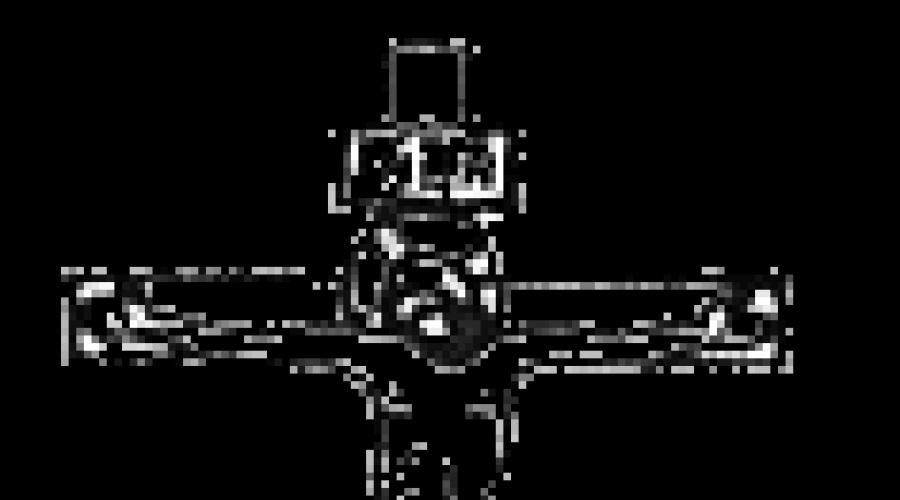
Read also
In the Old Testament church, which consisted mainly of Jews, crucifixion, as is known, was not used, and, according to custom, they were executed in three ways: stoned, burned alive, and hung on a tree. Therefore, “they write about the gallows: “Cursed is everyone hanging on a tree” (Deut. 21:23),” explains St. Demetrius of Rostov (Search, part 2, ch. 24). The fourth punishment - beheading with a sword - was added to them in the era of the Kings.
And the execution of the cross was then a pagan Greco-Roman tradition, and the Jewish people knew it only a few decades before the birth of Christ, when the Romans crucified their last legitimate king, Antigonus. Therefore, in the Old Testament texts there are not and cannot even be any similarities of the cross as an instrument of execution: both from the side of the name, and from the side of the form; but, on the contrary, there is a lot of evidence there: 1) about human deeds, prophetically foreshadowing the image of the Lord's cross, 2) about known objects, mysteriously denoting the power and tree of the cross, and 3) about visions and revelations, foreshadowing the very suffering of the Lord.
The cross itself is like a terrible weapon shameful execution, chosen by Satan as the banner of lethality, caused overwhelming fear and horror, but, thanks to Christ the Conqueror, he became a welcome trophy that evokes joyful feelings. Therefore, Saint Hippolytus of Rome, the Apostolic husband, exclaimed: “And the Church has her own trophy over death - this is the Cross of Christ, which she bears on herself,” and Saint Paul, the Apostle of tongues, wrote in his Epistle: “I want to boast (…) only in the cross of our Lord Jesus Christ”(Gal. 6:14). “Look how longed and cherished this so terrible and reproachful (shameful - Slavs.) Sign of the most cruel executions in ancient times has become,” testified St. John Chrysostom. And the Apostolic husband - St. Justin the Philosopher - argued: "The Cross, as the prophet foretold, is the greatest symbol of the power and authority of Christ" (Apology, § 55).
In general, the “symbol” is in Greek “connection”, and means either a means that implements connection, or the detection of an invisible reality through visible naturalness, or the expressibility of a concept by an image.
In the New Testament Church, which arose in Palestine mainly from former Jews, at first the instillation of symbolic images was difficult due to their adherence to their former traditions, which strictly forbade images and thereby protected the Old Testament church from the influence of pagan idolatry. However, as you know, the Providence of God already then gave her many lessons in symbolic and iconographic language. For example: God, forbidding the prophet Ezekiel to speak, commanded him to draw on a brick an image of the siege of Jerusalem as a “sign to the sons of Israel” (Ezek. 4:3). And it is clear that over time, with an increase in the number of Christians from other nations, where images were traditionally allowed, such a one-sided influence of the Jewish element, of course, weakened and gradually disappeared altogether.
Already from the first centuries of Christianity, due to the persecution of the followers of the crucified Redeemer, Christians were forced to hide, performing their rituals in secret. And the absence of Christian statehood - the external fence of the Church and the duration of such an oppressed situation were reflected in the development of worship and symbolism.
And to this day, precautionary measures have been preserved in the Church for the protection of the teaching itself and even the shrines from the harmful curiosity of the enemies of Christ. For example, the Iconostasis is a product of the Sacrament of Communion, subject to protective measures; or the diaconal exclamation: “Come out, ye catechumens,” between the liturgies of the catechumens and the faithful, undoubtedly reminds us that “we celebrate the Sacrament, having closed the doors, and forbid the uninitiated to be with him,” writes Chrysostom (Conversation 24, Matt.).
Let us recall how the famous Roman actor and mime Genesius, on the orders of Emperor Diocletian in 268, exhibited the Sacrament of Baptism in the circus as a mockery. What a miraculous effect the spoken words had on him, we see from the life of the blessed martyr Genesius: having repented, he was baptized and, together with the Christians prepared for public execution, "was the first to be beheaded." This one is far from the only fact desecration of the shrine is an example of the fact that many of the Christian mysteries have become known to the pagans for a long time.
"This world- according to the words of the Seer John, - all lying in evil"(1 John 5:19), and there is that aggressive environment in which the Church fights for the salvation of people and which forced Christians from the first centuries to use conditional symbolic language: abbreviations, monograms, symbolic images and signs.
This new language It helps the Church to initiate the new believer into the mystery of the Cross gradually, of course, taking into account his spiritual age. After all, the necessity (as a voluntary condition) of gradual disclosure of dogmas to the catechumens preparing to receive baptism is based on the words of the Savior Himself (see Matt. 7;6 and 1 Cor. 3:1). That is why St. Cyril of Jerusalem divided his sermons into two parts: the first of the 18 catechumens, where there is not a word about the Sacraments, and the second of the 5 sacraments, explaining to the faithful all the Church Sacraments. In the preface, he urges the catechumens not to pass on what they heard to outsiders: “when you experience the height of the taught, then you will know that the catechumens are not worthy to hear him.” And Saint John Chrysostom wrote: “I would like to speak openly about this, but I am afraid of the uninitiated. For they impede our conversation, forcing us to speak indistinctly and covertly.(Conversation 40, 1 Cor.). Blessed Theodoret, Bishop of Kirr, says the same thing: divine mysteries, because of the uninitiated, we talk secretly; after removing those who were worthy of secret knowledge, we teach them clearly ”(Question 15 Num.).
Thus, the pictorial symbols that enclose the verbal formulas of the dogmas and Sacraments not only improved the way of expression, but, being a new sacred language, even more reliably protected the church teaching from aggressive profanation. We are to this day, as taught Apostle Paul, “we preach the wisdom of God, secret, hidden”(1 Corinthians 2:7).
Cross T-shaped "Antonievskiy"
In the southern and eastern parts of the Roman Empire, a tool was used to execute criminals, called the "Egyptian" cross since the time of Moses and resembling the letter "T" in European languages. “The Greek letter T,” wrote Count A.S. Uvarov, “is one of the forms of the cross used for crucifixions” (Christian symbolism, M., 1908, p. 76)
“The number 300, expressed in Greek through the letter T, also served from the time of the Apostles to designate the cross,” says the well-known liturgist, Archimandrite Gabriel. - This Greek letter T is found in the inscription of the tomb of the III century, discovered in the catacombs of St. Callistus. (...) Such an image of the letter T is found on one carnelian engraved in the 2nd century ”(Guide to Liturgy, Tver, 1886, p. 344)
St. Demetrius of Rostov also argues about the same: “The Greek image, “Tav”, called, which the Angel of the Lord made "sign on forehead"(Ezek. 9:4) Saint Ezekiel the prophet saw in the revelation the holy people in Jerusalem, in order to protect them from impending slaughter. (…)
If we apply the title of Christ to this image at the top in this way, we will immediately see the four-pointed cross of Christ. Therefore, there Ezekiel saw a prototype of a four-pointed cross” (Search, M., 1855, book 2, ch. 24, p. 458).
Tertullian says the same thing: “The Greek letter Tav and our Latin T make up the real cross shape which, according to prophecy, should be depicted on our foreheads in true Jerusalem.
“If the letter T is found in Christian monograms, then this letter is located in such a way as to stand out more clearly in front of all others, since T was considered not only a symbol, but even the very image of the cross. An example of such a monogram is found on a sarcophagus of the 3rd century” (Gr. Uvarov, p. 81). According to Church Tradition, Saint Anthony the Great wore a cross-Tau on his clothes. Or, for example, Saint Zeno, bishop of the city of Verona, placed a cross in the shape of T on the roof of the basilica he built in 362.
Cross " Egyptian hieroglyph Ankh"
Jesus Christ - the Conqueror of death - through the mouth of the king-prophet Solomon announced: "Whoever finds me finds life"(Prov. 8:35), and after His incarnation he repeated: "I am seven risen and life"(John 11:25). Already from the first centuries of Christianity, the Egyptian hieroglyph "anch", denoting the concept of "life", was used to symbolize the life-giving cross, resembling it in shape.
Cross "letter"
And other letters (from different languages), given below, were also used by the first Christians as symbols of the cross. Such an image of the cross did not scare away the pagans, being familiar to them. “And indeed, as can be seen from the Sinai inscriptions,” reports Count A.S. Uvarov, “the letter was taken as a symbol and for a real image of the cross” (Christian symbolism, part 1, p. 81). In the first centuries of Christianity, of course, it was not the artistic side of the symbolic image that was important, but the convenience of its application to a hidden concept.
Cross "anchor-shaped"
Initially, this symbol was found by archaeologists on the Thessalonica inscription of the 3rd century, in Rome - in 230, and in Gaul - in 474. And from the “Christian Symbols” we learn that “in the caves of Pretextatus, slabs were found without any inscriptions, with one image of an “anchor”" (Gr. Uvarov, p. 114).
In his Epistle, the Apostle Paul teaches that Christians have the opportunity "take hold of the hope that lies ahead(i.e. Cross), which for the soul is, as it were, a safe and strong anchor.(Heb. 6:18-19). This one, according to the Apostle, "anchor", symbolically covering the cross from the reproach of the unfaithful, and revealing its true meaning to the faithful, as deliverance from the consequences of sin, is our strong hope.
The church ship, figuratively speaking, along the waves of a turbulent temporal life, delivers everyone to the quiet harbor of eternal life. Therefore, the “anchor”, being cruciform, became among Christians a symbol of hope for the strongest fruit of the Cross of Christ - the Kingdom of Heaven, although the Greeks and Romans, also using this sign, assimilated to it the meaning of “strength” only earthly affairs.
Cross monogram "pre-Konstantinovsky"
A well-known specialist in liturgical theology, Archimandrite Gabriel, writes that “in the monogram inscribed on the tombstone (3rd century) and in the form of the St. Andrew's Cross, vertically crossed by a line (Fig. 8), there is a cover image of the cross” (Rukov. p. 343) .
This monogram was compiled from Greek initial letters the name of Jesus Christ, by combining them crosswise: namely the letters “1” (yot) and the letters “X” (chi).
This monogram is often found in the post-Konstantinov period; for example, we can see her image in mosaic on the vaults of the Archbishop's Chapel of the end of the 5th century in Ravenna.
Cross-monogram "shepherd's staff"
Representing Christ the Shepherd, the Lord imparted miraculous power to the staff of Moses (Ex. 4:2-5) as a sign of pastoral power over the verbal sheep of the Old Testament church, then to the staff of Aaron (Ex. 2:8-10). The Divine Father, through the mouth of the prophet Micah, says to the Only Begotten Son: "Feed Your people with Your rod, the sheep of Your inheritance"(Micah 7:14). "I am the good shepherd; the good shepherd lays down his life for the sheep"(John 10:11), the beloved Son answers the Heavenly Father.
Count A. S. Uvarov, describing the finds of the Catacomb period, reported that: “A clay lamp found in Roman caves shows us very clearly how a bent staff was painted instead of the entire symbol of the shepherd. On the lower part of this lamp, the staff is depicted crossing the letter X, the first letter of the name of Christ, which together forms the monogram of the Savior ”(Christ. symbol. p. 184).
Initially, the shape of the Egyptian wand was exactly like a shepherd's crook, the upper part of which is bent down. All the bishops of Byzantium were awarded the "shepherd's staff" only from the hands of the emperors, and in the 17th century all Russian patriarchs received their primatial staff from the hands of the reigning autocrats.
Cross "Burgundy", or "Andreevsky"
The Holy Martyr Justin the Philosopher, explaining the question of how the pagans knew cruciform symbols even before the birth of Christ, argued: “What Plato says in Timaeus (...) about the Son of God (...) that God placed Him in the universe like a letter X, he also borrowed from Moses!. For in the Mosaic writings it is said that (...) Moses, by the inspiration and action of God, took brass and made the image of the cross (...) and said to the people: if you look at this image and believe, you will be saved through it (Numbers 21:8) ( John 3:14). (...) Plato read this and, not knowing exactly and not realizing that it was the image of a (vertical) cross, and seeing only the figure of the letter X, he said that the power closest to the first God was in the universe like the letter X ”(Apology 1, § 60).
The letter "X" of the Greek alphabet has already served as the basis for monogram symbols since the 2nd century, and not only because it hid the name of Christ; after all, as you know, “ancient writers find the shape of a cross in the letter X, which is called Andreevsky, because, according to legend, the Apostle Andrew ended his life on such a cross,” Archimandrite Gabriel wrote (Rukov. p. 345).
Around 1700, God's anointed Peter the Great, wishing to express religious difference Orthodox Russia from the heretical West, placed the image of the St. Andrew's Cross on State Emblem, on his hand seal, on the naval ensign, etc. His own explanation says that: "the cross of St. Andrew (accepted) for the sake of that from this Apostle Russia received holy baptism."
Cross "Monogram of Constantine"
To the Holy Equal-to-the-Apostles King Constantine “Christ the Son of God appeared in a dream with a sign seen in heaven and commanded, having made a banner similar to this one seen in heaven, to use it to protect against attacks by enemies,” narrates the church historian Eusebius Pamphilus in his “Book One on the Life of the Blessed King Constantine" (ch. 29). “This banner happened to be seen by us with our own eyes,” continues Eusebius (ch. 30). - It had the following appearance: on a long, gold-covered spear there was a transverse rail, which formed the sign of the cross (...) with the spear, and on it was a symbol of the saving name: two letters showed the name of Christ (...), from the middle of which came the letter "R". Subsequently, the Tsar had the custom to wear these letters on his helmet” (ch. 31).
“A combination of (combined) letters, known as the monogram of Constantine, composed of the first two letters of the word Christ - “Chi” and “Rho,” writes the liturgist Archimandrite Gabriel, “this Constantinian monogram is found on the coins of the Emperor Constantine” (p. 344) .
As is known, this monogram has become quite widespread: it was minted for the first time on the well-known bronze coin of Emperor Trajan Decius (249-251) in the Lydian city of Maeonia; was depicted on a vessel of 397; was carved on tombstones of the first five centuries or, for example, frescoed on plaster in the caves of St. Sixtus (Gr. Uvarov, p. 85).
Cross monogram "Post-Konstantinovsky"
“Sometimes the letter T,” writes Archimandrite Gabriel, “is found in conjunction with the letter R, which can be seen in the tomb of St. Callistus in the epitaph” (p. 344). This monogram is also found on the Greek plates found in the city of Megara, and on the tombstones of the cemetery of St. Matthew in the city of Tire.
words "Behold, your King"(John 19:14) Pilate first of all pointed out the noble origin of Jesus from the royal dynasty of David, in contrast to the rootless self-proclaimed tetrarchs, and this idea was stated in writing "over his head"(Matt. 27:37), which, of course, caused discontent among the power-hungry high priests, who stole power over the people of God from the kings. And that is why the Apostles, preaching the Resurrection of the crucified Christ and openly “venerating, as is evident from the Acts of the Apostles, Jesus as king” (Acts 17:7), endured severe persecution from the clergy through the deceived people.
The Greek letter "R" (ro) - the first in the word in Latin "Pax", in Roman "Rex", in Russian Tsar, - symbolizing King Jesus, is above the letter "T" (tav), meaning His cross; and together they recall the words from the Apostolic gospel that all our strength and wisdom is in the Crucified King (1 Cor. 1:23-24).
Thus, “and this monogram, according to the interpretation of St. Justin, served as a sign of the Cross of Christ (...), received such an extensive meaning in symbolism only after the first monogram. (...) In Rome (...) it became commonplace not before 355, and in Gaul - not before the 5th century ”(Gr. Uvarov, p. 77).
Cross monogram "sun-shaped"
Already on the coins of the 4th century there is a monogram "I" of Jesus "XP" is "sun-shaped", "For the Lord God- how to teach Holy Bible, - there is a sun"(Ps. 84:12).
The most famous, “Konstantinovskaya”, “monogram was subjected to some changes: a line or the letter “I” was added, crossing the monogram across” (Archim. Gabriel, p. 344).
This "sun-shaped" cross symbolizes the fulfillment of the prophecy about the all-enlightening and all-conquering power of the Cross of Christ: “But for you who revere my name, the Sun of righteousness will rise and its rays heal,- proclaimed by the Holy Spirit the prophet Malachi, - and you will trample the wicked; for they will be dust under your feet." (4:2-3).
Cross monogram "trident"
When the Savior passed near the Sea of Galilee, He saw fishermen throwing nets into the water, His future disciples. “And he said to them, Follow me, and I will make you fishers of men.”(Matthew 4:19). And later, sitting by the sea, He taught the people with His parables: “The kingdom of heaven is like a net thrown into the sea and seizing every kind of fish”(Matthew 13:47). "Recognizing in shells for fishing symbolic meaning Kingdom of Heaven, - says the "Christian Symbolism", - we can assume that all the formulas related to the same concept were iconically expressed by these common symbols. The trident, which was used to catch fish, as they now fish with hooks, should be attributed to the same shells ”(Gr. Uvarov, 147).
Thus, the trident monogram of Christ has long meant participation in the Sacrament of Baptism, as being caught in the net of the Kingdom of God. For example, on ancient monument sculptor Eutropius carved an inscription, speaking of his acceptance of baptism and ending with a trident monogram (Gr. Uvarov, p. 99).
Cross monogram "Konstantinovsky"It is known from church archeology and history that on ancient monuments of writing and architecture there is often a variant of combining the letters "Chi" and "Rho" in the monogram of the holy King Constantine, the God-chosen successor of Christ the Lord on the throne of David.
Only from the 4th century did the constantly depicted cross begin to free itself from the monogram shell, lose its symbolic coloring, approaching its real form, resembling either the letter “I” or the letter “X”.
These changes in the image of the cross occurred due to the emergence of Christian statehood, based on its open veneration and glorification.
Cross round "nahlebnaya"
According to an ancient custom, as Horace and Martial testify, Christians cut the baked bread crosswise to make it easier to break it. But long before Jesus Christ, this was a symbolic transformation in the East: the incised cross, dividing the whole into parts, unites those who used them, heals separation.
Such round loaves are depicted, for example, on the inscription of Sintrophion divided into four parts by a cross, and on the tombstone from the cave of St. Lukina divided into six parts by a monogram of the 3rd century.
In direct connection with the Sacrament of Communion, chalices, phelonions and other things depicted bread as a symbol of the Body of Christ, broken for our sins.
The circle itself, before the birth of Christ, was depicted as the idea of immortality and eternity, not yet personified. Now, by faith, we understand that “the Son of God Himself is an endless circle,” according to the words of St. Clement of Alexandria, “in which all forces converge.”
Catacomb cross, or "sign of victory"
“In the catacombs and in general on ancient monuments, four-pointed crosses are incomparably more common than any other form,” Archimandrite Gabriel notes. This image of the cross has become especially important for Christians since God Himself showed in heaven the sign of the four-pointed cross ”(Rukov. p. 345).
The well-known historian Eusebius Pamphal narrates in detail how all this happened in his Book One on the Life of the Blessed Tsar Constantine.
“Once, at noon, when the sun was already beginning to lean toward the west,” the Tsar said, “I saw with my own eyes the sign of the cross, composed of light and lying on the sun, with the inscription “Conquer this!” This spectacle seized with horror both himself and the whole army that followed him and continued to contemplate the miracle that had appeared (ch. 28).
It was on the 28th day of October 312, when Constantine marched with his army against Maxentius, who was imprisoned in Rome. This miraculous appearance of the cross in broad daylight has been witnessed by many contemporary writers from the words of eyewitnesses.
Particularly important is the testimony of the confessor Artemius before Julian the Apostate, to whom Artemius said during interrogation:
“Christ called Constantine from above when he waged war against Maxentius, showing him at noon the sign of the cross, shining radiantly over the sun and star-shaped Roman letters predicting victory in the war for him. Being there ourselves, we saw His sign and read the letters, saw him and the whole army: there are many witnesses to this in your army, if you only want to ask them ”(ch. 29).
“By the power of God, the holy Emperor Constantine won a brilliant victory over the tyrant Maxentius, who did impious and villainous deeds in Rome” (ch. 39).
Thus, the cross, which used to be an instrument of shameful execution among the pagans, became under Emperor Constantine the Great a sign of victory - the triumph of Christianity over paganism and the subject of the deepest reverence.
For example, according to the short stories of the holy Emperor Justinian, such crosses were supposed to be placed on contracts and meant a signature “worthy of all trust” (book 73, ch. 8). The acts (decisions) of the Councils were also fastened with the image of the cross. One of the imperial decrees says: “we command every conciliar act, which is approved by the sign of the holy Cross of Christ, to be preserved and so be as it is.”
In general, this form of the cross is most often used in ornaments.
for decorating temples, icons, priestly vestments and other church utensils.
The cross in Rus' is "patriarchal", or in the West "Lorensky"The fact proving the use of the so-called "patriarchal cross" since the middle of the last millennium is confirmed by numerous data from the field of church archeology. It was this form of the six-pointed cross that was depicted on the seal of the governor of the Byzantine Emperor in the city of Korsun.
The same type of cross was widespread in the West under the name of "Lorensky".
For an example from the Russian tradition, let us point out at least the large copper cross of St. Avraamy of Rostov of the 18th century, stored in the Andrei Rublev Museum of Old Russian Art, cast according to iconographic samples of the 11th century.
Four-pointed cross, or Latin "immissa"
In the textbook "Temple of God and church services"It is reported that" a strong motivation for honoring the direct image of the cross, and not the monogram, was the acquisition of the Honest and Life-Giving Cross mother of the holy Tsar Constantine, Equal-to-the-Apostles Elena. As the direct image of the cross spreads, it gradually acquires the form of the Crucifixion ”(SP., 1912, p. 46).
In the West, the most common now is the "immiss" cross, which the schismatics - admirers of imaginary antiquity - scornfully call (for some reason in Polish) "roof in Latin" or "Rymsky", which means - the Roman cross. These detractors of the four-pointed cross and devout admirers of the osmikonomy, apparently, need to be reminded that, according to the Gospel, the execution of the cross was spread throughout the Empire precisely by the Romans and, of course, was considered Roman.
And not according to the number of trees, not according to the number of ends, the Cross of Christ is revered by us, but according to Christ Himself, Whose holy blood was stained with, - St. Dimitry of Rostov denounced the schismatic philosophies. - And, showing miraculous power, any cross does not act by itself, but by the power of Christ crucified on it and by invoking His most holy name ”(Search, book 2, ch. 24).
Accepted by the Universal Church into use "Canon Holy Cross"- the creation of St. Gregory of Sinai - sings of the Divine power of the Cross, containing everything heavenly, earthly and underworld: "The all-honourable Cross, four-pointed power, splendor of the Apostle" (song 1), "Behold the four-pointed Cross, having height, depth and breadth" (song . 4).
Starting from the 3rd century, when such crosses first appeared in the Roman catacombs, the entire Orthodox East still uses this form of the cross as equal to all others.
Papal CrossThis form of the cross was most often used in the hierarchal and papal services of the Roman Church in the 13th-15th centuries and therefore was called the "papal cross".
To the question about the foot, depicted at right angles to the cross, we will answer with the words of St. Demetrius of Rostov, who said: “I kiss the foot of the cross, if it is oblique, if not oblique, and the custom of the cross-makers and cross-writers, as consistent with the church, I do not dispute, I condescend” (Search, book 2, chapter 24).
Six-pointed cross "Russian Orthodox"The question of the reason for the inscription of the lower crossbar tilted is quite convincingly explained by the liturgical text of the 9th hour of the service to the Cross of the Lord:“In the midst of two thieves, the measure of righteousness, having found Your Cross: the first I am brought down to hell with the burden of blasphemy, while the other I am relieved from sins to the knowledge of theology”. In other words, both on Golgotha for two thieves, and in life for each person, the cross serves as a measure, as if the scales of his inner state.
To one thief who is brought down to hell "burden of blasphemy", pronounced by him on Christ, he became, as it were, the crossbar of the scales, bowed down under this terrible weight; another thief, freed by repentance and the words of the Savior: "today you will be with me in paradise"(Luke 23:43), the cross elevates to the Kingdom of Heaven.
This form of the cross in Rus' has been used since ancient times: for example, the worship cross, arranged in 1161 by the Monk Euphrosyne, Princess of Polotsk, was six-pointed.
six-pointed Orthodox cross, along with others, was used in Russian heraldry: for example, on the coat of arms of the Kherson province, as explained in the "Russian armorial" (p. 193), a "silver Russian cross" is depicted.
Orthodox octagonal cross
Eight-pointedness - most corresponds to the historically reliable form of the cross on which Christ was already crucified, as Tertullian, St. Irenaeus of Lyon, St. Justin the Philosopher and others testify. “And when Christ the Lord carried a cross on His shoulders, then the cross was still four-pointed; because there was still no title or footstool on it. (...) There was no footstool, because Christ had not yet been raised on the cross and the soldiers, not knowing where Christ's feet would reach, did not attach footstools, having finished it already at Golgotha, ”St. Dimitry of Rostov denounced the schismatics (Search, Prince 2, chapter 24). There was also no title on the cross before the crucifixion of Christ, because, as the Gospel reports, at first "Crucified Him"(John 19:18), and then only "Pilate wrote the inscription and placed(by your order) on the cross"(John 19:19). It was at first divided by lot "His clothes" warriors, "they crucified him"(Matthew 27:35), and only then “They put an inscription over His head, signifying His guilt: This is Jesus, the King of the Jews”(Matthew 27:3.7).
So, the four-pointed Cross of Christ, carried to Golgotha, which everyone who has fallen into the demonic schism calls the seal of the Antichrist, is still called in the Holy Gospel "His cross" (Matthew 27:32, Mark 15:21, Luke 23:26 , John 19:17), that is, the same as with the tablet and footstool after the crucifixion (John 19:25). In Rus', the cross of this form was used more often than others.
Seven-pointed cross
This form of the cross is quite often found on the icons of northern painting, for example, the Pskov school of the 15th century: the image of St. Paraskeva Pyatnitsa with life is from the Historical Museum, or the image of St. Demetrius of Thessalonica - from the Russian; or the Moscow school: "Crucifixion" by Dionysius - from the Tretyakov Gallery, dated 1500.
We see the seven-pointed cross on the domes of Russian churches: for example, we will cite the wooden Ilyinsky Church of 1786 in the village of Vazentsy (Holy Rus, St. Petersburg, 1993, ill. 129), or we can see it above the entrance to the Cathedral of the Resurrection New Jerusalem Monastery, built by Patriarch Nikon .
At one time, theologians heatedly discussed the question of what kind of mystical and dogmatic meaning does the footstool have as part of the redemptive Cross?
The fact is that the Old Testament priesthood received, so to speak, the opportunity to make sacrifices (as one of the conditions) thanks to "golden footstool attached to the throne"(Par. 9:18), which, as it is still with us Christians, according to God's ordinance, was sanctified through chrismation: “And anoint them,” said the Lord, “the altar of burnt offering and all its utensils, (…) and its base. And sanctify them, and there will be great holiness: everything that touches them will be sanctified.”(Ex. 30:26-29).
Thus, the foot of the cross is that part of the New Testament altar, which mystically points to the priestly service of the Savior of the world, who voluntarily paid with His death for the sins of others: for the Son of God "Our sins He Himself bore in His body on the tree"(1 Pet. 2:24) Cross, "sacrifice himself"(Heb. 7:27) and thus "being made high priest forever"(Heb. 6:20), established in His person "The priesthood is eternal"(Heb. 7:24).
And so it is stated in the "Orthodox Confession of the Eastern Patriarchs": "On the cross, He fulfilled the office of the Priest, offering Himself as a sacrifice to God and the Father for the redemption of the human race" (M., 1900, p. 38).
But let's not confuse the foot Holy Cross, revealing to us one of its mysterious sides, with two other footstools from the Holy Scriptures. - explains St. Dmitry Rostovsky.
“David says, “Exalt the Lord our God, and worship at His footstool; holy It"(Ps. 99:5). And Isaiah says on behalf of Christ: (Isaiah 60:13), explains Saint Demetrius of Rostov. There is a footstool that is commanded to worship, and there is a footstool that is not commanded to be worshiped. God says in Isaiah's prophecy: "Heaven is my throne, and the earth is my footstool"(Is. 66:1): no one should worship this footstool - the earth, but only God, its Creator. And it is also written in the psalms: "The Lord (Father) said to my Lord (Son), Sit at my right hand until I make your enemies your footstool"(Pis. 109:1). And this footstool of God, the enemies of God, who wants to worship? What footstool does David command to worship?” (Search, book 2, chapter 24).
To this question the very word of God on behalf of the Savior answers: "and when I am lifted up from the earth"(John 12:32) - “from my footstool” (Is. 66:1), then "I will glorify my footstool"(Isaiah 60:13)- "foot of the altar"(Ex. 30:28) of the New Testament - the Holy Cross, which casts down, as we confess, Lord, "Your enemies for Your footstool"(Ps. 109:1), and therefore "worship the foot(Cross) His; holy It!(Ps. 99:5), "a footstool attached to a throne"(2 Chr. 9:18).
Cross "crown of thorns"The image of a cross with a crown of thorns has been used for many centuries by various peoples who have adopted Christianity. But instead of numerous examples from the ancient Greco-Roman tradition, we will give several cases of its use in later times according to the sources that were at hand. A cross with a crown of thorns can be seen on the pages of an ancient Armenian manuscriptbooksthe period of the Cilician kingdom (Matenadaran, M., 1991, p. 100);on the icon“Glorification of the Cross” of the 12th century from the Tretyakov Gallery (V. N. Lazarev, Novgorod icon painting, M., 1976, p. 11); on Staritsky copper-castcross- vest of the XIV century; oncover"Golgotha" - the monastic contribution of Tsarina Anastasia Romanova in 1557; on silverplatterXVI century (Novodevichy Convent, M., 1968, ill. 37), etc.
God told sinning Adam that “Cursed be the earth for you. Thorns and thistles she will grow for you"(Gen. 3:17-18). And the new sinless Adam - Jesus Christ - voluntarily took upon himself other people's sins, and death as a consequence of them, and thorny suffering, leading to it through thorny path.
Christ's Apostles Matthew (27:29), Mark (15:17) and John (19:2) tell that "The soldiers wove a crown of thorns and put it on his head", "and by his stripes we are healed"(Isaiah 53:5). From this it is clear why the wreath has since symbolized victory and reward, starting with the books of the New Testament: "crown of truth"(2 Tim. 4:8), "crown of glory"(1 Pet. 5:4), "crown of life"(James 1:12 and Rep. 2:10).
Cross "gallows"This form of the cross is very widely used in the decoration of churches, liturgical objects, hierarchal vestments, and in particular, as we see, bishops' omophorions on the icons of the "three ecumenical teachers".
“If someone tells you, do you worship the Crucified One? You answer with a bright voice and with a cheerful face: I worship and will not stop worshiping. If he laughs, you shed tears about him, because he is raging,” teaches us, the ecumenical teacher St. John Chrysostom himself, decorated on images with this cross (Conversation 54, on Matt.).
A cross of any shape has unearthly beauty and life-giving power, and everyone who knows this God's wisdom exclaims with the Apostle: "I (…) I wish to boast (…) only by the cross of our Lord Jesus Christ"(Gal. 6:14)!
Cross "vine"
I am the true vine, and my Father is the vinedresser.”(John 15:1). This is how Jesus Christ called himself, the Head of the Church planted by Himself, the only source and conductor of spiritual, holy life for all Orthodox believers, who are members of His body.
“I am the vine and you are the branches; Whoever abides in Me and I in him bears much fruit."(John 15:5). “These words of the Savior Himself laid the foundation for the symbolism of the vine,” wrote Count A.S. Uvarov in his work “Christian Symbolism”; the main meaning of the vine for Christians was in a symbolic connection with the sacrament of communion” (pp. 172 - 173).
Cross "petal"The variety of forms of the cross has always been recognized by the Church as quite natural. According to the expression of St. Theodore the Studite - "a cross of any form is a true cross." Very common in church fine arts“petal” cross, which, for example, is seen on the omophorion of St. Gregory the Wonderworker of the 11th-century mosaic of the Hagia Sophia of Kyiv.
“By a variety of sensory signs, we are hierarchically elevated to a uniform union with God,” explains the famous teacher of the Church, St. John of Damascus. From the visible to the invisible, from the temporal to eternity - such is the path of a person led by the Church to God through the comprehension of grace-filled symbols. The history of their diversity is inseparable from the history of the salvation of mankind.
Cross "Greek", or Old Russian "korsunchik"
Traditional for Byzantium and the most frequently and widely used form of the so-called "Greek cross". The same cross is considered, as you know, to be the most ancient "Russian cross", since, according to the Church Devotion, the holy prince Vladimir took out from Korsun, where he was baptized, just such a cross and installed it on the banks of the Dnieper in Kiev. A similar four-pointed cross has survived to this day in the Kiev Sophia Cathedral, carved on the marble board of the tomb. Prince Yaroslav, son of St. Vladimir the Equal-to-the-Apostles.
Often, to indicate the universal significance of the Cross of Christ as a microuniverse, the cross is depicted as inscribed in a circle, symbolizing the cosmological sphere of heaven.
Cross "dome" with a crescent
It is not surprising that the question about the cross with a crescent is often asked, since the "dome" is located in the most prominent place of the temple. For example, the domes of the Cathedral of St. Sophia of Vologda, built in 1570, are decorated with such crosses.
Typical of the pre-Mongol period, this form of a domed cross is often found in the Pskov region, once on the dome of the Church of the Assumption of the Virgin in the village of Meletovo, erected in 1461.
In general, the symbolism of an Orthodox church is inexplicable from the point of view of aesthetic (and therefore static) perception, but, on the contrary, it is quite open for understanding precisely in liturgical dynamics, since almost all elements of temple symbolism, in different places worship take on different meanings.
“And a great sign appeared in heaven: a woman clothed with the sun,- says in the Revelation of John the Theologian, - the moon under her feet(Apoc. 12:1), and patristic wisdom explains: this moon marks the font in which the Church, baptized into Christ, is clothed in Him, in the Sun of righteousness. The crescent is also the cradle of Bethlehem, which received the Divine Infant Christ; the crescent is the Eucharistic cup in which the Body of Christ is located; the crescent is a church ship, led by the Pilot Christ; the crescent is also the anchor of hope, the gift of the cross of Christ; the crescent moon is also the ancient serpent trampled down by the Cross and placed as an enemy of God under the feet of Christ.
Cross "trefoil"
In Russia, this form of the cross is used more often than others for the manufacture of altar crosses. But, however, we can see it on state symbols. “A golden Russian trifoliate cross standing on a silver overturned crescent”, as reported in the Russian Heraldry, was depicted on the coat of arms of the Tiflis province
The golden “shamrock” (Fig. 39) is also on the coat of arms of the Orenburg province, on the coat of arms of the city of Troitsk, Penza province, the city of Akhtyrka, Kharkov and the city of Spassk, Tambov provinces, on the coat of arms provincial city Chernihiv, etc.
Cross "Maltese", or "St. George"
Patriarch Jacob prophetically honored the Cross when "bowed down in faith, As the Apostle Paul says, on top of his rod"(Heb. 11:21), “a rod,” explains St. John of Damascus, “which served as an image of the cross” (On holy icons, 3 verses). That is why today there is a cross above the handle of the bishop's baton, "for cross we, - writes St. Simeon of Thessalonica, - we are guided and grazed, we are sealed, we have children, and, having mortified passions, we are drawn to Christ ”(ch. 80).
In addition to the usual and widespread church use, this form of the cross, for example, was officially adopted by the Order of St. John of Jerusalem, formed on the island of Malta and openly fought against Freemasonry, which, as you know, organized the murder Russian Emperor Pavel Petrovich - the patron saint of the Maltese. So the name appeared - "Maltese cross".
According to Russian heraldry, some cities had golden “Maltese” crosses on their coats of arms, for example: Zolotonosha, Mirgorod and Zenkov of the Poltava province; Pogar, Bonza and Konotop of the Chernihiv province; Kovel Volynskoy,
Perm and Elizavetpol provinces and others. Pavlovsk St. Petersburg, Vindava Courland, Belozersk Novgorod provinces,
Perm and Elizavetpol provinces and others.
All those who were awarded the crosses of St. George the Victorious of all four degrees, were called, as you know, "cavaliers of St. George."
Cross "Prosphora-Konstantinovsky"
For the first time, these words in Greek "IC.XP.NIKA", which means "Jesus Christ the Conqueror", were written in gold on three large crosses in Constantinople by the Equal-to-the-Apostles Emperor Constantine himself.
“To him who overcomes I will grant to sit with Me on My throne, just as I also overcame and sat down with My Father on His throne.”(Rev. 3:21), says the Savior, the Conqueror of hell and death.
According to ancient tradition, an image of a cross is printed on the prosphora with the addition of words meaning this victory of the cross of Christ: "IC.XC.NIKA". This "prosphora" seal means the redemption of sinners from sinful captivity, or, in other words, the great price of our Redemption.
Old-printed cross "wicker"
“This weaving was obtained from ancient Christian art,” Professor V. N. Shchepkin authoritatively reports, “where it is known in carving and mosaics. Byzantine weaving, in turn, passes to the Slavs, among whom it is in ancient era especially common in Glagolitic manuscripts” (Textbook of Russian Paleography, M., 1920, p. 51).
Most often, images of "wicker" crosses are found as decorations in Bulgarian and Russian old printed books.
Cross four-pointed "drop-shaped"
Having sprinkled the cross tree, the drops of the Blood of Christ forever informed the cross of His power.
Greek Gospel of the 2nd century from the State public library opens with a sheet depicting a beautiful “drop-shaped” four-pointed cross (Byzantine miniature, M., 1977, pl. 30).
And also, for example, we recall that among the copper pectoral crosses cast in the first centuries of the second millennium, as is known, there are often “drop-shaped” encolpions (in Greek- "on the chest").
At the beginning of Christ"drops of blood falling to the ground"(Luke 22:44), became a lesson in the fight against sin even"till blood"(Heb. 12:4); when on the cross from Him"blood and water flowed out"(John 19:34), then by example they were taught to fight evil even to death.
"To him(Savior) who loved us and washed us from our sins with his own blood."(Apoc. 1:5), who saved us "by the blood of His cross" (Col. 1:20), - Glory forever!
Cross "crucifixion"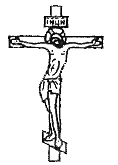
One of the first images of the crucified Jesus Christ that has come down to us dates back only to the 5th century, on the doors of the church of St. Sabina in Rome. From the 5th century, the Savior began to be depicted in a long robe of a collobia - as if leaning against a cross. It is this image of Christ that can be seen on early bronze and silver crosses Byzantine and Syrian origin of the 7th-9th centuries.
The 6th century saint Anastasius of Sinai wrote an apologetic ( in Greek- “protection”) the composition “Against the acephalus” - a heretical sect that denies the unity of two natures in Christ. To this work he attached an image of the crucifixion of the Savior as an argument against Monophysitism. He conjures the copyists of his work, together with the text, to transfer inviolably the image attached to it, as, by the way, we can see on the manuscript of the Vienna Library.
Another, even more ancient surviving image of the crucifixion is on the miniature of the Ravvula Gospel from the Zagba monastery. This 586 manuscript belongs to the Saint Lawrence Library in Florence.

Until the 9th century inclusive, Christ was depicted on the cross not only alive, resurrected, but also triumphant, and only in the 10th century did images of the dead Christ appear (Fig. 54).
From ancient times, crucifixion crosses, both in the East and in the West, had a crossbar to support the feet of the Crucified, and His feet were depicted as nailed each separately with their own nail. The image of Christ with crossed feet, nailed with one nail, first appeared as an innovation in the West in the second half of the 13th century.
On the cross-shaped halo of the Savior, the Greek letters UN were necessarily written, meaning "truly Existing", because "God said to Moses: I am who I am"(Ex. 3:14), thereby revealing His name, expressing the self-existence, eternity and immutability of the being of God.
From the Orthodox dogma of the Cross (or Atonement), the idea undoubtedly follows that the death of the Lord is the ransom of all, the calling of all peoples. Only the cross, unlike other executions, made it possible for Jesus Christ to die with outstretched arms calling "all ends of the earth"(Isaiah 45:22).
Therefore, in the tradition of Orthodoxy, it is to portray the Savior Almighty precisely as the Resurrected Crusader, holding and calling the whole universe into His arms and bearing the New Testament altar - the Cross. The prophet Jeremiah also spoke about this on behalf of the haters of Christ: "Let us put wood into His bread"(11:19), that is, we will put the tree of the cross on the body of Christ, which is called heavenly bread (St. Demetrius Rost. cit. op.).
And the traditionally Catholic image of the crucifixion, with Christ sagging in his arms, on the contrary, has the task of showing how it all happened, depicting the suffering and death before death, and not at all what is essentially the eternal Fruit of the Cross - His triumph.
Schema Cross, or "Golgotha"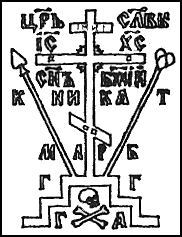
The inscriptions and cryptograms on Russian crosses have always been much more diverse than on Greek ones.
From the 11th century under the lower oblique crossbar eight-pointed cross appears a symbolic image of the head of Adam, buried according to legend on Golgotha ( in Hebrew- “frontal place”), where Christ was crucified. These words of his clarify the prevailing in Rus' to XVI century tradition to produce the following designations near the image of "Golgotha": "M.L.R.B." - the place of the frontal was crucified, "G.G." - Mount Golgotha, "G.A." - the head of Adamov; moreover, the bones of the hands lying in front of the head are depicted: right on the left, as during burial or communion.
The letters "K" and "T" mean a spear of a warrior and a cane with a sponge, depicted along the cross.
The inscriptions are placed above the middle crossbar: "IC" "XC" - the name of Jesus Christ; and under it: "NIKA" - the Winner; on the title or near it there is an inscription: "SN" "BZHIY" - the Son of God sometimes - but more often there is no "I.N.Ts.I" - Jesus of Nazareth King of the Jews; the inscription above the title: "ЦРЪ" "СЛАВЫ" - the King of Glory.
Such crosses are supposed to be embroidered on the vestments of the great and angelic schema; three crosses on the paraman and five on the kukul: on the forehead, on the chest, on both shoulders and on the back.
The Calvary cross is also depicted on the funeral shroud, which marks the preservation of the vows given at baptism, like the white shroud of the newly baptized, meaning cleansing from sin. During the consecration of temples and houses depicted on the four walls of the building.
Unlike the image of the cross, which directly depicts the Crucified Christ Himself, the sign of the cross conveys it spiritual significance, depicts its real meaning, but does not show the Cross itself.
“The cross is the guardian of the whole universe. The Cross is the beauty of the Church, the Cross is the power of the kings, the Cross is the faithful affirmation, the Cross is the glory of the angel, the Cross is the plague of the devil, "- affirms the absolute Truth of the luminaries of the feast of the Exaltation of the Life-Giving Cross.
The motives for the outrageous desecration and blasphemy of the Holy Cross by conscious crusaders and crusaders are quite understandable. But when we see Christians involved in this heinous deed, it is all the more impossible to be silent, for - according to the words of St. Basil the Great - "God is given up in silence"!
So called " playing cards”, available, unfortunately, in many homes, is an instrument of demon-communication, through which a person will certainly come into contact with demons - the enemies of God. All four card "suits" mean nothing more than the cross of Christ, along with other sacred objects equally revered by Christians: a spear, a sponge and nails, that is, everything that was the instruments of suffering and death of the Divine Redeemer.
And out of ignorance, many people, turning “into a fool”, allow themselves to blaspheme the Lord, taking, for example, a card with the image of the “shamrock” cross, that is, the cross of Christ, which half the world worships, and, throwing it carelessly with the words (forgive me, Lord !) "club", which in Yiddish means "nasty" or "evil spirits"! Moreover, these daredevils, who played suicide, essentially believe that this cross is “beaten” by some lousy “trump six”, not at all knowing that “trump card” and “kosher” are written, for example, in Latin, the same.
It would be high time to clarify the true rules of all card games, in which all players remain “in the fools”: they consist in the fact that ritual sacrifices, in Hebrew called by the Talmudists “kosher” (that is, “clean”), supposedly have power over Life-Giving Cross!
If you know that playing cards cannot be used for other purposes than defiling Christian shrines to the delight of the demons, then the role of the cards in "fortune-telling" - these nasty searches for demonic revelations - will become extremely clear. In this regard, is it necessary to prove that anyone who has touched a deck of cards and has not brought sincere repentance in confession for the sins of blasphemy and blasphemy has a guaranteed registration in hell?
So, if “clubs” are the blasphemy of raging gamblers on specially depicted crosses, which they also call “crosses”, then what do “blame”, “hearts” and “tambourines” mean? We won't bother translating these curses into Russian either, since we don't have a Yiddish textbook; better to open New Testament to shed on the demonic tribe the unbearable Light of God for them.
Saint Ignatius Brianchaninov imperative mood edifies: "get acquainted with the spirit of the times, study it, so as to avoid its influence as far as possible."
The card suit “blame”, or otherwise “spade”, blasphemes the gospel peak, then As the Lord predicted about His perforation, through the mouth of the prophet Zechariah, that "They will look at the one they pierced"(12:10), so it happened: one of the warriors(longin) pierced his side with a spear"(John 19:34).
The card suit "worms" blasphemes the gospel sponge on a cane. As Christ warned about His poisoning, through the mouth of the king-prophet David, that the soldiers “They gave me bile for food, and in my thirst they gave me vinegar to drink”(Ps. 69:22), and so it came to pass: “one of them took a sponge, gave it vinegar to drink, and put it on a reed, gave it to Him to drink”(Matthew 27:48).
The card suit of “tambourine” blasphemes the gospel forged tetrahedral jagged nails with which the hands and feet of the Savior were nailed to the tree of the Cross. As the Lord prophesied about his clove cross, through the mouth of the psalmist David, that"pierced my hands and my feet"(Ps. 22:17), and so it came to pass: Apostle Thomas who said“Unless I see in His hands the wounds from the nails, and I do not put my finger in the wound from the nails, and I do not put my hand in His side, I will not believe”(John 20:25), "I believed because I saw"(John 20:29); And Apostle Peter, addressing his fellow tribesmen, testified:"Men of Israel! he said, Jesus of the Nazarene (…)
you took and nailed(to the cross) hands(Romans) lawless, killed; but God raised him up"(Acts 2:22, 24).
The unrepentant thief crucified with Christ, like today's gamblers, blasphemed the sufferings of the Son of God on the Cross and, out of arrogance, out of impenitence, went forever to fullness; but the prudent thief, setting an example for all, repented on the cross and thereby inherited eternal life with God. Therefore, let us firmly remember that for us Christians there can be no other object of hope and hope, no other support in life, no other banner that unites and inspires us, except for the only saving sign of the invincible Cross of the Lord!
Cross gammatic
 |
This cross is called "Gammatic" because it consists of the Greek letter "Gamma". Already the first Christians in the Roman catacombs depicted a gamma cross. In Byzantium, this form was often used to decorate the Gospels, church utensils, temples, and was embroidered on the vestments of Byzantine saints. In the 9th century, by order of the Empress Theodora, a Gospel was made, decorated with gold ornaments from gamma crosses.
The gamma cross is very similar to the ancient Indian sign of the swastika. The Sanskrit word swastika or su-asti-ka means supreme being or perfect bliss. This is an ancient solar, that is, associated with the sun, symbol that appears already in the era Upper Paleolithic, is widespread in the cultures of the Aryans, ancient Iranians, is found in Egypt and China. Of course, the swastika was known and revered in many areas of the Roman Empire during the era of the spread of Christianity. The ancient pagan Slavs were also familiar with this symbol; images of the swastika are found on rings, temporal rings and other jewelry, as a sign of the sun or fire, says Priest Mikhail Vorobyov. Christian church, which has a powerful spiritual potential, was able to rethink, church many cultural traditions pagan antiquity: from ancient philosophy to household rituals. Perhaps the gamma cross entered into Christian culture like a churched swastika.
And in Rus', the form of this cross has long been used. It is depicted on many church items of the pre-Mongolian period, in the form of a mosaic under the dome of the Hagia Sophia of Kyiv, in the ornament of the doors of the Nizhny Novgorod Cathedral. Gamma crosses are embroidered on the phelonion of the Moscow Church of St. Nicholas in Pyzhy.
Kuznetsov V.P.
The history of the development of the shape of the cross.
Short Course in Orthodox Staurography
(Moscow: Almanac "Eternal Life", 1997 - 40 p.).
Moscow. "Eternal Life" 1997
Kuznetsov V.P. The history of the development of the form of the cross.
A short course in Orthodox staurography. - Moscow: Almanac "Eternal Life", 1997. - 40 s.
Appendix to the almanac "Eternal Life". Circulation 800 eq. The publication is carried out as a manuscript.
For the first time, the attention of the God-loving reader is offered a brief review that most interesting part of Sacred Tradition Orthodox Church, which contains a valuable mystical-dogmatic and moral-aesthetic experience traditional use of various images of the cross in the history of Christianity. The various symbols and signs that accompany every Christian on his way to Heaven are a special language Holy Church, the knowledge of which is necessary for each of its members, therefore the brochure can be recommended as study guide By catechesis most a wide range readers.
Introduction.
At old testament church , consisting mainly of Jews, crucifixion, as you know, was not used, and they were executed, according to custom, in three ways: stoned, burned alive and hung on a tree. Therefore, “and they write about the gallows:“ Cursed everyone hanging on a tree"(Deut. 21; 23), "the Saint explains" Dimitri Rostov (Search, part 2, ch. 24). The fourth punishment - beheading with a sword - was added to them in the era of the Kings.
And the execution of the cross was then a pagan Greco-Roman tradition, and the Jewish people knew it only a few decades before the birth of Christ, when the Romans crucified their last legitimate king Antigone. Therefore, in the Old Testament texts there are not and cannot even be any similarities of the cross as an instrument of execution: both from the side of the name, and from the side of the form; but, on the contrary, there is plenty of evidence:
1) about human deeds, image who prophetically foreshadowed the cross of the Lord,
2) about things known, strength and tree the cross that mystically ordained and
3) about visions and revelations, the most suffering who foreshadowed the Lord.
The cross itself, as a terrible instrument of shameful execution, chosen by Satan as the banner of lethality, caused overwhelming fear and horror, but, thanks to Christ the Victorious, it became a coveted trophy that evoked joyful feelings. Therefore the saint Hippolyte Rimsky - the Apostolic husband - exclaimed: “and the Church has her own trophy over death - this is the Cross of Christ, which she wears on herself” and holy Paul- The Apostle of tongues - wrote in his Epistle: “I want to boast (…) only in the cross of our Lord Jesus Christ”(Gal. 6; 14). “Look how much desired and lovable this so terrible and diarrhea(shameful - Slavs.) in antiquities the Omen cruelest executions,” testified St. John Chrysostom. And the Apostle's husband is a saint justin Philosopher - said: “The cross, as the prophet foretold, is the greatest symbol power and authority of Christ"(Apology, § 55).
In general "symbol" - in Greek "compound" , and means either a means of connecting, or detection invisible reality through visible naturalness, or expressibility image concepts.
In the New Testament Church, which arose in Palestine mainly from former Jews, at first the instillation of symbolic images was difficult due to their adherence to their former traditions, strictly forbidding images and thereby protecting the Old Testament church from the influences of pagan idolatry. However, as you know, the Providence of God already then gave her many lessons in symbolic and iconographic language. For example: God forbidding the prophet Yezekiel to speak, commanded him to draw on a brick image siege of Jerusalem "sign to the sons of Israel" (Ezek. 4; 3). And it is clear that over time, with an increase in the number of Christians from other nations, where images were traditionally allowed, such a one-sided influence of the Jewish element, of course, weakened and gradually disappeared altogether.
Already from the first centuries of Christianity, due to the persecution of the followers of the crucified Redeemer, Christians were forced to hide, performing their rituals in secret. And the absence of Christian statehood - the external fence of the Church and the duration of such an oppressed situation were reflected in the development of worship and symbolism.
And to this day, precautionary measures have been preserved in the Church for the protection of the teaching itself, and even of the holy things, from the harmful curiosity of the enemies of Christ. For example, the Iconostasis is a product of the Sacrament of Communion, subject to protective measures; or the deacon's exclamation: "Come out the catechumens" between the liturgies of the catechumens and the faithful no doubt reminds us that “We perform the Sacrament, closing the doors, and forbid the uninitiated to be with him” , - writes Chrysostom (Conversation 24, Matt.).
Let us recall how the famous Roman actor and mime Genesius, on the orders of Emperor Diocletian in 268, exhibited in the circus for ridicule sacrament of baptism. What a miraculous effect the spoken words had on him, we see from the life of the blessed martyr Genesia: having repented, he was baptized and, together with the Christians prepared for public execution, "was the first to be beheaded." This is far from the only fact of the desecration of the shrine - an example of the fact that many of the Christian mysteries have become known to the pagans for a long time.
"This world — by the word of the seer John -all lying in evil" (1 John 5; 19),
and there is that aggressive environment in which the Church fights for the salvation of people and which forced Christians from the very first centuries to use conventional symbolic language: abbreviations, monograms, symbolic images and signs.
This New Language of the Church Helps Initiate the New Believer into the Mystery of the Cross gradually, of course, taking into account his spiritual age. After all, necessity (as a voluntary condition) gradualism in the disclosure of dogmas to the catechumens preparing to receive baptism, is based on the words of the Savior Himself (see Matt. 7; b and 1 Cor. 3; 1). That is why the saint Kirill Jerusalem divided his sermons into two parts:
the first - out of 18 catechumens, where there is not a word about the Sacraments, and
the second - from 5 sacraments, explaining to the faithful all the sacraments of the Church.
In the preface, he urges the catechumens not to pass on what they hear to outsiders: “When you know by experience the height of what is being taught, then you will know that those who are announced are not worthy to hear him” . And the saint John Chrysostom wrote: “I would like to speak openly about this, but I am afraid of the uninitiated. For they impede our conversation, forcing us to speak unclearly and covertly” (Conversation 40, 1 Cor.). The same is said of the blessed Theodorita Bishop of Cyrus: “On the divine mysteries, for the reason of the uninitiated, we talk in secret; after removing those who were worthy of secret knowledge, we teach them clearly ”(Question 15 Num.).
Thus, the pictorial symbols, enclosing the verbal formulas of dogmas and Sacraments, not only improved the way of expression, but also, being a new sacred language, even more reliably protected church teaching from aggressive profanity. We are to this day, as the Apostle taught Paul, “we preach the wisdom of God, secret, hidden” (1 Cor. 2; 7).
Cross T-shaped "Antoniev".
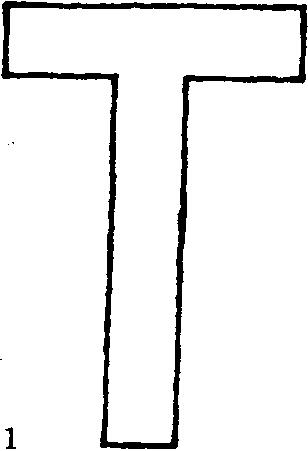
Rice. 01. Cross T-shaped "Antoniev".
In the southern and eastern parts of the Roman Empire, a tool was used to execute criminals, called the “Egyptian” cross since the time of Moses and resembling the letter “T” in European languages (Fig. 1). "Greek letter T,- wrote Count A.S. Uvarov, - one of the forms of the cross used for crucifixions "(Christian symbolism, M., 1908, p. 76).
“The number 300, expressed in Greek through the letter T, also served from the time of the Apostles to designate cross, — reports the famous liturgist archimandrite Gabriel. —This Greek letter T is found in a 3rd-century tomb inscription discovered in the catacombs of St. Callista.(...) Such an image of the letter T is found on one carnelian engraved in the 2nd century”(Guide to Liturgy, Tver, 1886, p. 344).
The saint speaks of the same Dimitri Rostov: “Greek image, “Tav” called, by which the Angel of the Lord made a “sign on their foreheads”(Ezek. 9; 4)
God's people in Jerusalem, to guard against impending slaughter, were seen in revelation by the saint Ezekiel prophet. “(...) If we apply the title of Christ to this image above in this way (Fig. 2), we will immediately see the four-pointed cross of Christ. Therefore, there I saw Ezekiel transformation of the four-pointed cross ”(Search, M., 1855, book 2, ch. 24, p. 458). The same asserts Tortullian:

Rice. 02. Cross T-shaped "Antoniev".
“The Greek letter Tav and our Latin T make up the true form cross, which, according to prophecy, should be depicted on our foreheads in true Jerusalem ”.
“If the letter T is found in Christian monograms, then this letter is located in such a way as to stand out more clearly in front of all others, since T was considered not only a symbol, but even the very image of the cross. An example of such a monogram is found on a 3rd century sarcophagus.”
(Gr. A.S. Uvarov, p. 81).
According to Church Tradition, St. Anthony The Great One wore a cross-Tau on his robes. Or, for example, a saint zenon, Bishop of the city of Verona, placed on the roof, erected by him in 362 of the basilica, a cross in the shape of T.
Cross "Egyptian hieroglyph Ankh".

Rice. 03. Cross "Egyptian hieroglyph Ankh".
Jesus Christ - the Conqueror of death - through the mouth of the king's prophet Solomon announced: "Who found me, that found life » (Prov. 8; 35), and after His incarnation he repeated: "I am the resurrection and life» (John 11; 25). Already from the first centuries of Christianity for the symbolic image of the cross life-giving the Egyptian hieroglyph "anch" was used, resembling it in form, denoting the concept of "life" (Fig. 3).
Cross "letter".
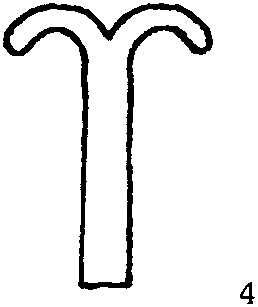
Rice. 04. Cross "letter".
And other letters (from different languages), given below, were also used by the first Christians as symbols of the cross. Such an image of the cross did not scare away the pagans, being familiar to them. “And indeed, as can be seen from the Sinai inscriptions,” reports Count A.S. Uvarov, “the letter (Fig. 4) was taken as a symbol and for a real image cross» (Christian symbolism, part 1, p. 81). In the first centuries of Christianity, of course, it was not the artistic side of the symbolic image that was important, but the convenience of its application to a hidden concept.
Anchor cross.
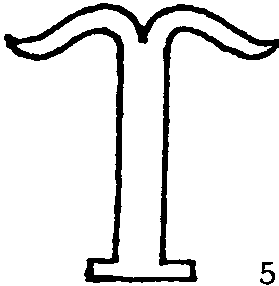
Rice. 05. Anchor-shaped cross.
Initially, this symbol came across to archaeologists on the Thessalonica inscription of the 3rd century, in Rome - in 230, and in Gaul - in 474. And from the “Christian Symbolism” we learn that: “in the caves of Pretextatus, plates were found without any inscriptions, with one image "anchors"(Fig. 5) ”(Gr. A.S. Uvarov, p. 114).
In his Epistle the Apostle Paul teaches that Christians have the opportunity "take up the present hope (i.e. Cross), which for the soul is as if anchor safe Andstrong"(Heb. 6; 18-19).
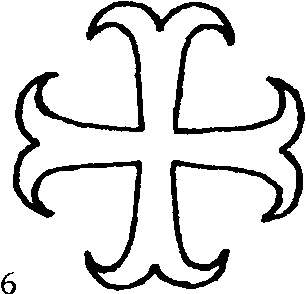
Rice. 06. Anchor cross.
This one, according to the Apostle, "anchor", symbolically covering the cross from the desecration of the unfaithful, and revealing its true meaning to the faithful, as deliverance from the consequences of sin, is our strong hope(Fig. 6).

Rice. 07. Anchor cross.
The church ship, figuratively speaking, along the waves of a stormy temporary life, delivers everyone to a quiet marina eternal life. Therefore, the “anchor”, being cruciform, became among Christians a symbol of hope for the strongest fruit of the Cross of Christ - the Kingdom of Heaven, although the Greeks and Romans, also using this sign, assimilated to it the meaning of “strength” only earthly affairs (Fig. 7).
Cross monogram "pre-Konstantinovsky".
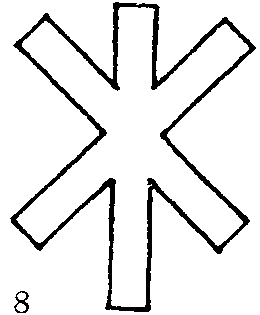
Rice. 08. Monogram cross "pre-Konstantinovsky".
A well-known specialist in liturgical theology - archimandrite Gabriel writes that “in the monogram inscribed on the tombstone (3rd century) and having the shape of the St. Andrew's cross, vertically crossed by a line (Fig. 8), there is a hiddenthe image of the cross ”(Guide. p. 343).

Rice. 09. Monogram cross "pre-Konstantinovsky".
This monogram was composed of the Greek initial letters of the name of Jesus Christ, by crossing them: namely the letter "I" (yot) and the letter "X" (chi).
This monogram is often found in the post-Konstantinov period; for example, we can see her image in mosaic on the vaults of the Archbishop's chapel of the end of the 5th century in Ravenna (Fig. 9).
Cross-monogram "shepherd's staff".

Rice. 10. Cross-monogram "shepherd's staff".
Representing Christ the Shepherd The Lord told the staff Moses miraculous power (Ex. 4; 2-5) as a sign pastoral power over the verbal sheep of the Old Testament church, then the staff Aaron(Ex. 7; 8-10). Divine Father, through the mouth of a prophet Micah, says to the Only Begotten Son: "Feed your people wand Yours, the sheep of Your inheritance"(Mic 7; 14). "I am shepherd Kind: shepherd a good man lays down his life for the sheep"(John 10; 11), the beloved Son answers the Heavenly Father.
Count A.S. Uvarov, describing the finds of the Catacomb period, reported that: “A clay lamp found in Roman caves shows us very clearly how the curved staff instead the entire character shepherd. On the lower part of this lamp, the staff is depicted crossing the letter X, the first letter of the name of Christ, which together forms the monogram of the Savior.(Christ. symbol p. 184).
Initially, the shape of the episcopal baton was similar to the shepherd's staff, the upper part of which was bent down (Fig. 10). All the bishops of Byzantium were awarded the "shepherd's staff" only from the hands of the emperors, and in the 17th century all Russian patriarchs received their primatial baton from the hands of the reigning autocrats.
Cross "Burgundy" or "Andreevsky".
holy martyr justin The philosopher, explaining the question of how the pagans knew cruciform symbols even before the birth of Christ, argued: “What Plato says in Timaeus (...) about the Son of God (...), that God placed Him in the universe like the letter X, he also borrowed from Moses. For in the Mosaic writings it is said that (...) Moses, by the inspiration and action of God, took brass and made image of the cross(...) and said to the people: if you look at this image and believe, you will be saved through it (Num. 21; 8) (John 3; 14). (...) Plato read this, and not knowing exactly and not realizing that it was the image of a (vertical) cross, and seeing only the figure of the letter X, he said that the power closest to the first God was in the universe like the letter X ”(Apology 1, § 60).

cross shape Andrey» , — wrote archimandrite Gabriel(Manual p. 345).
Peter "Cross of the Holy Andrew .
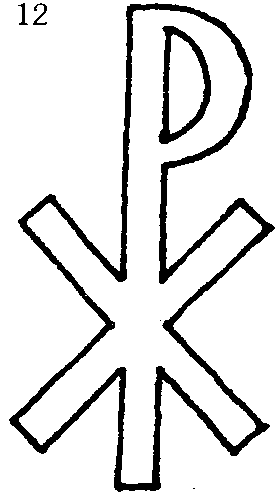
Rice. 12. Cross "Monogram of Constantine".
The letter "X" of the Greek alphabet has already served as the basis for monogram symbols since the 2nd century, and not only because it hid the name of Christ; because, as you know, “ancient writers find cross shape in the letter X, which is called St. Andrew's, because, according to legend, the Apostle ended his life on such a cross Andrey» , — wrote archimandrite Gabriel(Manual p. 345).
Around 1700 God's Anointed Peter The Great, wishing to express the religious difference between Orthodox Russia and the heretical West, placed the image of the St. Andrew's Cross (Fig. 11) on the State Emblem, on his hand seal, on the naval flag, etc. His own handwritten explanation states that: "Cross of the Holy Andrew(accepted) for the sake of the fact that Russia received holy baptism from this Apostle..
Cross "monogram of Constantine".

Rice. 13. Cross "Monogram of Constantine".
As you know, this monogram has become quite widespread:
was minted for the first time on the well-known bronze coin of the emperor Trajan Decius (249-251) in the Lydian city of Meonia (Fig. 13);
was depicted on a vessel of 397;
was carved on tombstones of the first five centuries or, for example,
frescoed on plaster in the caves of St. Sixtus (Gr. A.S. Uvarov, p. 85).
Cross monogram "Post-Konstantinovsky".
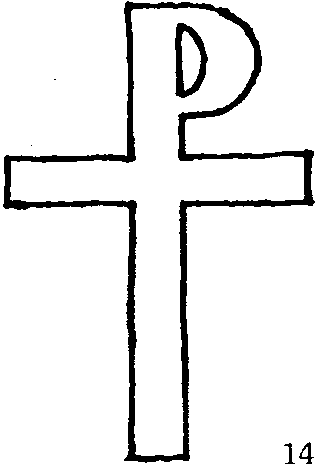
Rice. 14. Monogram cross "post-Konstantinovsky".
“Sometimes the letter T,” writes the archimandrite Gabriel - found in conjunction with the letter P, which can be seen in the tomb of St. Callistus in the epitaph” (p. 344). This monogram is also found on the Greek plates found in the city of Megara, and on the tombstones of the cemetery of St. Matthew in the city of Tire.
The words "behold, Tsar your"(John 19:14) Pilate first of all pointed out the noble origin of Jesus from the royal Dynasty David unlike the rootless self-styled tetrarchs, and this idea was expressed in writing "over his head"(Matt. 27; 37), which, of course, caused discontent among the power-hungry high priests, who stole power from the kings over the people of God. And that is why the Apostles, preaching the Resurrection of the crucified Christ and openly " honoring - As can be seen from the Acts of the Apostles, king Jesus"(Acts 17; 7), endured severe persecution from the clergy through the deceived people.
Greek letter " R" (ro) - the first in the word Pax, in Roman Rex, in Russian Tsar, - symbolizing the Tsar-Jesus, is located above the letter " T» (tav), meaning His cross; and together they recall the words from the Apostolic gospel, that all our strength and wisdom is in the Crucified king(1 Cor. 1; 23-24).
Thus, “and this monogram (Fig. 14), according to the interpretation of the saint justina, served as a sign of the Cross of Christ (...), received such an extensive meaning in symbolism only after the first monogram (Fig. 12). (…) In Rome (…) became commonplace not before 355, and in Gaul not before the 5th century” (Gr. Uvarov, p. 77).
Cross monogram "solar-shaped".
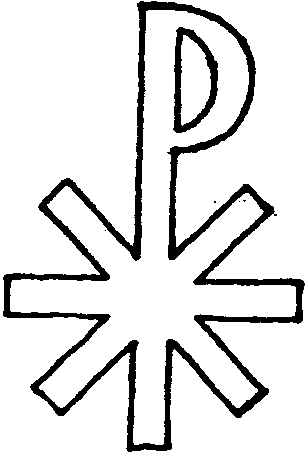
Rice. 15. Cross monogram "sun-shaped".
Already on the coins of the 4th century there is a monogram “ I"-Jesus" XP"-ista" solar-shaped "," for God, - as Scripture teaches, There is Sun» (Ps. 84; 12).
The most famous "Konstantinov" (Fig. 12) "monogram was subjected to some changes: another line or letter was added" I"crossing the monogram across" (Archim. Gabriel, p. 344),
This "sun-shaped" cross (Fig. 15) symbolizes the fulfillment of the prophecy about the all-enlightening and all-conquering power of the Cross of Christ: "AND for you who revere my name will rise Sun of Truth and healing in its rays, proclaimed by the Holy Spirit the prophet Malachi -and you will trample the wicked; for they will be dust under your feet." (4; 2-3).
Cross monogram "trident".
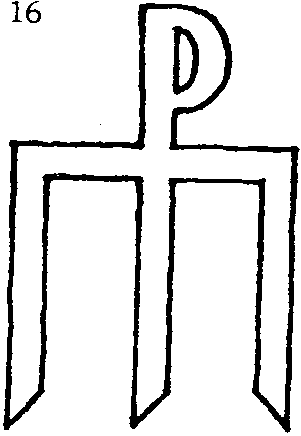
Rice. 16. Cross monogram "trident".
When the Savior passed near the Sea of Galilee, He saw fishermen throwing nets into the water, His future disciples. “And he said to them: Follow me, and I will make you catchers people"(Matthew 4; 19). And later, sitting by the sea, He taught the people with His parables: "Like the kingdom of heaven net, thrown into the sea and capturing fish of all kinds"(Mt. 13; 47). “Recognizing in shells for fishing the symbolic meaning of the kingdom of heaven,” says the “Christian Symbolism,” we can assume that all formulas related to the same concept, iconically expressed by these common symbols. To the same shells should be attributed trident, with which they fished, as they now fish with hooks ”(Gr. A.S. Uvarov, p. 147). Thus, the trident monogram of Christ (Fig. 16) has long meant participation in the Sacrament of Baptism, as catches on the net Kingdom of God. For example, on the ancient monument of the sculptor Eutropius, an inscription is carved, which speaks of his acceptance of baptism and ends with a trident monogram (Gr. A.S. Uvarov, p. 99).
Cross monogram "Konstantinovsky".

Rice. 17. Cross monogram "Konstantinovsky".
From church archeology and history it is known that on ancient monuments of writing and architecture there is often a variant of combining the letters " Hee" And " Ro» in the monogram of the holy King Constantine, The God-chosen successor of Christ the Lord on the throne of David (Fig. 17).
Only from the 4th century did the gradually depicted cross begin to free itself from the monogram shell, lose its symbolic coloring, approaching its real form, reminiscent of the letter “ T", then the letter " X».
These changes in the image of the cross occurred due to the emergence of Christian statehood, based on its open veneration and glorification.
Cross round "nahlebnaya". According to ancient custom, as evidenced Horace and Martial Christians cut the baked bread crosswise to make it easier to break it. But long before Jesus Christ, this was a symbolic transformation in the East: an incised cross, dividing the whole into parts, unites those who used them, heals division.
Such round loaves are depicted, for example, on the inscription of Sintrophion divided into four parts by a cross (Fig. 18), and on the tombstone from the cave of St. Lukina divided into six parts by a monogram of the 3rd century (Fig. 19).
Rice. 18-19. Cross round "nahlebnaya".
In direct connection with the Sacrament of Communion, chalices, phelonions and other things depicted bread as a symbol of the Body of Christ, broken for our sins.
The circle itself, before the birth of Christ, was depicted as the idea of immortality and eternity, not yet personified. Now, by faith, we understand that “the Son of God Himself is an infinite circle, - according to the saint Clement Alexandria, in which all forces converge.
Catacomb cross or "sign of victory".
“In the catacombs and in general on ancient monuments, four-pointed crosses are incomparably more common than any other form,- notes the archimandrite Gabriel. —This image of the cross has become especially important for Christians since God Himself showed the sign of the four-pointed cross in heaven.(Manual p. 345).
How it all happened is described in detail by the famous historian Eusebius Pamphilus in his "The first book about the life of the blessed Tsar Constantine".
“Once, at noon hours of the day, when the sun was already beginning to decline towards the west,” said the Tsar, “I saw with my own eyes what was composed of light and lying on the sun the sign of the cross with the inscription "Sim win!" This spectacle seized with horror both himself and the whole army that followed him and continued to contemplate the miracle that had appeared (ch. 28).
It was on the 28th day of October 312, when Konstantin marched with an army against Maxentius, who was imprisoned in Rome. It's wonderful appearance of the cross in broad daylight, it has also been witnessed by many modern writers, according to eyewitnesses.
Confessor's testimony is especially important Artemia before Julian the Apostate, who, during interrogation Artemy said: "Christ from above called Constantine, when he waged war against Maxentius, showing him at noon sign of the cross radiantly shone over the sun and in star-shaped Roman letters predicted to him victory at war. Being there ourselves, we saw His sign and read the letters, saw him and the whole army:
there are many witnesses to this in your army, if you only want to ask them ”(ch. 29).
Holy Emperor by the power of God Konstantin won a brilliant victory over the tyrant Maxentius, who did impious and villainous deeds in Rome” (ch. 39).
Thus, the cross, which used to be an instrument of shameful execution among the pagans, became under the Emperor Constantine Great substitute for victory the triumph of Christianity over paganism and the subject of the deepest reverence.
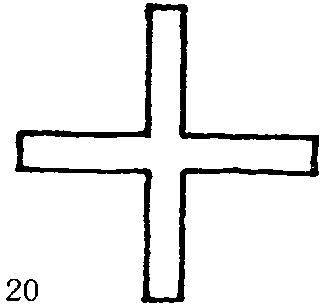
Rice. 20. Catacomb cross or "sign of victory".
For example, according to the stories of the Holy Emperor justinian, similar crosses (Fig. 20) were supposed to be placed on contracts and meant a signature “worthy of all trust” (book 73, ch. 8). The acts (decisions) of the Councils were also fastened with the image of the cross. One of the imperial decrees says: “we command every conciliar act that is approved the sign of the holy cross Christ, so keep it and so it should be, as it is ".
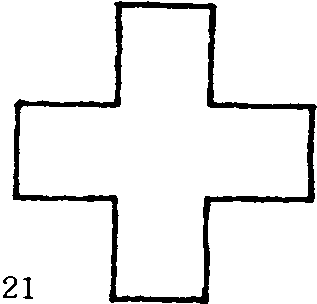
Rice. 21. Catacomb cross or "sign of victory".
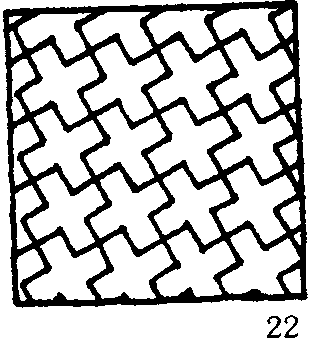
Rice. 22. Catacomb cross or "sign of victory".
In general, this form of the cross (Fig. 21) is most often used in ornaments (Fig. 22) to decorate temples, icons, priestly vestments and other church utensils.
The cross in Rus' is "patriarchal", or in the West "Lorensky".
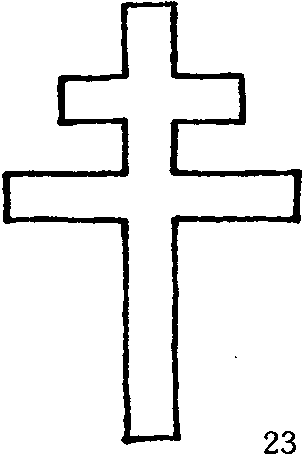
Rice. 23. The cross in Rus' is "patriarchal", or in the West "Lorensky".
A fact proving the use since the middle of the last millennium of the so-called " patriarchal cross”, is confirmed by numerous data from the field of church archeology. It was this form of the six-pointed cross (Fig. 23) that was depicted on the seal of the governor of the Byzantine Emperor in the city of Korsun.
The same type of cross was widespread in the West under the name "Lorensky".
For an example from the Russian tradition, let us point out at least the large copper cross of St. Abrahamia Rostov of the 18th century, cast according to iconographic samples of the 11th century.
Cross four-pointed or Latin "immissa".
The textbook “The Temple of God and Church Services” reports that “a strong motivation for honoring the direct image of the cross, and not the monogram, was the acquisition of the Precious and Life-Giving Cross by the mother of the holy Tsar Constantine, Equal-to-the-Apostles Elena. As the direct image of the cross spreads, it gradually acquires the form of the Crucifixion ”(St. Petersburg, 1912, p. 46).
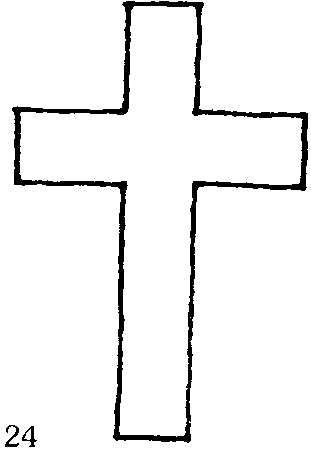
Rice. 24. Four-pointed cross or Latin "immissa".
In the West, the most common now is the “immiss” cross (Fig. 24), which the schismatics - admirers of imaginary antiquity - scornfully call (for some reason in Polish)"Kryzh Latin" or "Rymsky", which means - the Roman cross. These detractors of the four-pointed cross and devout admirers of osmikonomy, apparently, need to be reminded that, according to the Gospel, the execution of the cross was distributed throughout the Empire precisely by the Romans and, of course, was considered Roman.
“And not according to the number of trees, not according to the number of ends, the Cross of Christ is revered by us, but according to Christ Himself, Whose holy blood was stained with,” the saint denounced the schismatic philosophies Dimitri Rostov, “And manifesting miraculous power, any cross does not act by itself, but by the power of Christ crucified on it and the invocation of His holy name” (Search, book 2, ch. 24).
The “Canon of the Holy Cross” adopted by the Universal Church is the work of St. Gregory Sinaita - sings of the Divine power of the Cross, containing everything heavenly, earthly and underworld: “The all-honorable Cross, four-pointed strength, grandeur of the Apostle ”(song 1),“ Behold quadruple Cross, having height, depth and breadth” (song 4).
Starting from the 3rd century, when such crosses first appeared in the Roman catacombs, the entire Orthodox East still uses this form of the cross as equal to all others.
Papal cross.
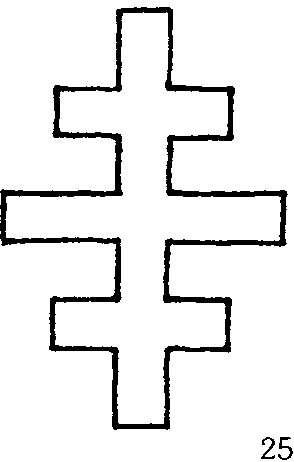
Rice. 25. Papal cross.
This form of the cross was most often used in the hierarchal and papal services of the Roman Church in the 13th-15th centuries and therefore was called the "papal cross" (Fig. 25). To the question about the foot, depicted at right angles to the cross, we will answer with the words of the saint Demetrius Rostovsky, who said: “I kiss the foot of the cross, if it’s oblique, if not oblique and the custom of cross-makers and cross-writers, as consistent with the church, I do not dispute, I indulge” (Search, book 2, ch. 24).
Six-pointed cross "Russian-Orthodox".
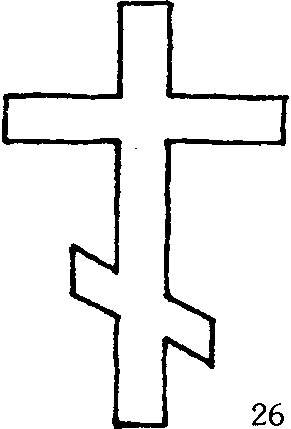
Rice. 26. Six-pointed cross "Russian-Orthodox".
The question of the reason for the design of the lower crossbar tilted quite convincingly explained by the liturgical text of the 9th hour of the service to the Cross of the Lord: “In the midst of two thieves, the measure of righteousness, having found Your Cross: the first I am brought down to hell with the burden of blasphemy, while the other I am relieved from sins to the knowledge of theology.” In other words, both on Golgotha for two thieves, and in life for each person, the cross serves as a measure, as if the scales of his inner state.
To one thief who is brought down to hell "by a burden blasphemy", uttered by him against Christ, he became, as it were, the crossbar of a scale, bowed down under this terrible weight; another thief, freed by repentance and the words of the Savior: "today you will be with me in paradise"(Luke 23; 43), the cross elevates to the Kingdom of Heaven.
This form of the cross in Rus' has been used since ancient times: for example, the worship cross, arranged in 1161 by St. Euphrosyne Princess Polotskaya, was six-pointed.
The six-pointed Orthodox cross, along with others, was used in Russian heraldry: for example, on the coat of arms of the Kherson province, as explained in the Russian Heraldry (p. 193), a “silver Russian cross” is depicted (Fig. 26).
Orthodox octagonal cross.

Rice. 27. Orthodox octagonal cross.
Eight-pointed - most corresponds to the historically reliable form of the cross, on which was already crucified Christ, as they testify Tertullian saint Irenaeus Lyon, saint justin Philosopher and others. “And when Christ the Lord bore the cross on His shoulders, then the cross was still four-pointed; because not been yet on it title, no foot.(...) There was no footstool, because Christ had not yet been raised on the cross, and the soldiers, not knowing where Christ's feet would reach, did not attach footstools, having finished it already at Golgotha, ”the Saint denounced the schismatics Dimitri Rostov (Search, book 2, ch. 24). There was also no title on the cross before the crucifixion of Christ, because, as the Gospel reports, at first "Crucified Him"(John 19; 18), and then only "Pilate wrote the inscription and placed(by his own order) cross"(John 19; 19). It was at first divided by lot "His clothes" warriors "they crucified Him"(Mt. 27; 35), and only then “They put an inscription over His head, signifying His guilt: This is Jesus, the King of the Jews”(Mt. 27; 37).
So, quadruple The Cross of Christ, carried to Golgotha, which all who have fallen into the rage of schism call the seal of the Antichrist, is called in the Holy Evangelion nevertheless "His Cross"(Matt. 27; 32. Mk. 15; 21, Luke 23; 26, John 19; 17), that is, the same as with the tablet and footstool after the crucifixion (John 19; 25). In Rus', a cross of this form (Fig. 27) was used more often than others.
Seven-pointed cross.

Rice. 28. Seven-pointed cross.
This form of the cross (Fig. 28) is quite often found on the icons of northern writing, for example, the Pskov school of the 15th century: the image of a saint Paraskeva Fridays with life - from the Historical Museum, or the image of the saint Demetrius Thessalonica - from Russian; or Moscow school: "Crucifixion" work Dionysia - from the Tretyakov Gallery, dated 1500.
We also see the seven-pointed cross on the domes of Russian churches: let us cite, for example, the wooden Ilyinsky Church of 1786 in the village of Vazentsy (Holy Rus', St. Petersburg, 1993, ill. 129) or we can see it above the entrance to the Cathedral of the Resurrection New Jerusalem Monastery, built Patriarch Nikon.
At one time, theologians heatedly discussed the question of what kind of mystical and dogmatic meaning does foot as part of the atoning cross?
The fact is that Old Testament priesthood received, so to speak, the opportunity to bring victims (as one of the conditions) thanks to the "gold foot, attached to the throne"(2 Chron. 9; 18), which, as it is still with us Christians, according to God's ordinance, was sanctified through chrismation: "and anoint them, - the Lord said, altar of burnt offering and all his belongings, (...) and its foot. And sanctify them, and there will be great holiness: everything that touches them will be sanctified.”(Ex. 30; 26-29).
Thus, foot the cross is that part of the New Testament altar that mystically points to priestly ministry of the Savior of the world, who voluntarily paid with His death for the sins of others: for the Son of God "Our sins He Himself bore in His body on the tree"(1 Pet. 2; 24) Cross, "sacrifice himself"(Heb. 7; 27) and thus "having become high priest forever"(Heb. 6; 20), established in His person "The priesthood is eternal"(Heb. 7; 24).
And so it is stated in the "Orthodox Confession of the Eastern Patriarchs": "On the cross He fulfilled position of priest offer yourself as a sacrifice to God and the Father for the redemption of the human race” (M., 1900, p. 38).
But let's not confuse foot saint cross, revealing to us one of its mysterious sides, with two other footstools from the Holy Scriptures.
"David says, "Praise the Lord our God, and worship foot His; holy It!(Ps. 99; 5). A Isaiah on behalf of Christ says: "I will glorify foot my feet"(Is. 60; 13), - explains the saint Dimitri Rostov. There is a footstool that is commanded to worship, and there is a footstool that is not commanded to be worshipped.
God says in Isaiah's prophecy: "Heaven my throne, but the earth - foot my feet"(Is. 66; 1): this footstool - earth no one should worship, but only God, the Creator of it. And it is also written in the psalms: "said the Lord (Father) to the Lord(to son) mine: sit at my right hand until I put your enemies in foot your feet"(Ps. 109; 1). And this footstool of God, enemies God, who wants to worship? What foot to worship David commands?" (Search, book 2, chapter 24).
To this question the very word of God on behalf of the Savior answers: “and when I am lifted up from land» (John 12; 32) - “ from foot my feet"(Is. 66; 1), then "I will glorify foot my feet"(Isaiah 60; 13) - "foot of the altar"(Ex. 30; 28) New Testament - Holy cross, deposing, as we confess, Lord, "Thy enemies in foot your feet"(Ps. 109; 1), and therefore "worship foot (Cross) His; holy It""(Ps. 99; 5), « foot, attached to the throne" (2 Steam. 9; 18).
Cross "crown of thorns".
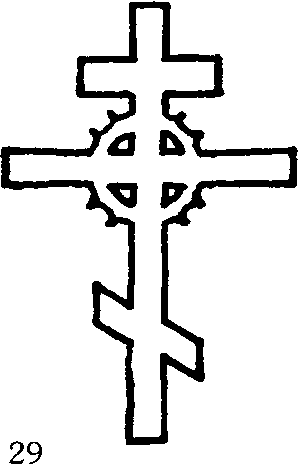
Rice. 29. Cross "crown of thorns".
Image of a cross with crown of thorns(Fig. 29) has been used for many centuries by various peoples who have adopted Christianity. But instead of numerous examples from the ancient Greco-Roman tradition, we will give several cases of its use in later times according to the sources that were at hand. Cross with crown of thorns can be seen on the pages of an ancient Armenian manuscript books the period of the Cilician kingdom (Matenadaran, M., 1991, p. 100);
on icon“Glorification of the Cross” of the 12th century from the Tretyakov Gallery (V.N. Lazarev, Novgorod icon painting, M., 1976, p. 11);
on the Staritsky copper-cast cross vest of the 14th century; on cover"Golgotha" - the monastic contribution of Tsarina Anastasia Romanova in 1557;
on silver platter 16th century (Novodevichy Convent, Moscow, 1968, ill. 37), etc.
God told sinning Adam that “Cursed be the earth for you. Thorn and thistles she will sprout for you"(Gen. 3; 17-18). And the new sinless Adam - Jesus Christ - voluntarily took upon himself the sins of others, and death as a consequence of them, and thorny suffering, to her leading the thorny path. Christ's Apostles Matthew (27; 29), Mark (15; 17) and John (19; 2) tell that "warriors, gossip crown of thorns, put it on his head", "and by his stripes we were healed"(Isaiah 53; 5). From this it is clear why since then wreath symbolizes victory and reward, starting with the books of the New Testament: "crown of truth"(2 Tim. 4; 8), "crown of glory"(1 Pet. 5; 4), "crown of life"(James 1; 12 and Apoc 2; 10).
Cross "gallows".
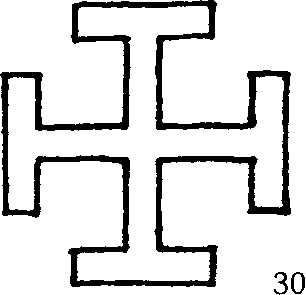
Rice. 30. Cross "gallows".
This form of the cross is very widely used in decorating churches, liturgical items, hierarchal vestments, and in particular, as we see, bishops' omophorions on the icons of the "three ecumenical teachers" (Fig. 30-31).

Rice. 31. Cross "gallows".
“If someone tells you, do you worship the crucified? You answer with a bright voice and with a cheerful face: I worship and will not stop worshiping. If he laughs, you shed tears about him, because he is mad, ”he teaches us, himself adorned on the images with this cross (Fig. 30), the ecumenical teacher of the saint John Chrysostom (Conversation 54, on Matt.).
The cross of any form has an unearthly beauty and life-giving power, and everyone who knows this God's wisdom exclaims with the Apostle: “I (...) I wish to boast (...) only cross Our Lord Jesus Christ"(Gal. 6; 14)!
Cross "vine".
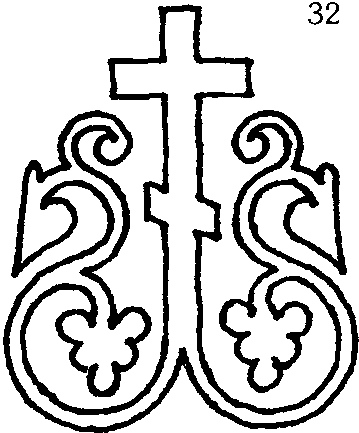
Rice. 32. Cross "vine".
"I I am true vine, and my Father is a vinedresser"(John 15; 1). This is how Jesus Christ called himself, the Head of the Church planted by Himself, the only source and conductor of spiritual, holy life for all Orthodox believers, who are members of His body.
"I am vine, and you branches; Whoever abides in Me and I in him bears much fruit."(John 15; 5).
“These words of the Savior Himself laid the foundation for the symbolism grape vine - wrote Count A. S. Uvarov in his work "Christian Symbols" - the main meaning vine(Fig. 32) for Christians was in a symbolic connection with the Sacrament of Communion” (pp. 172-173).
Cross "petal".

Rice. 33. Petal cross.
The variety of forms of the cross has always been recognized by the Church as quite natural. In the words of the Reverend Theodora Studita - "cross any form is the true cross. Very often found in church fine art is the “petal” cross (Fig. 33), which, for example, is seen on the omophorion of the saint Gregory Mosaic of the 11th century wonderworker of the Hagia Sophia of Kyiv.
“By a variety of sensual signs, we are hierarchically elevated to a uniform union with God”, - explains the famous teacher of the Church, St. John Damascus. From the visible to the invisible, from the temporal to eternity - such is the path of a person led by the Church to God through the comprehension of grace-filled symbols. The history of their diversity is inseparable from the history of the salvation of mankind.
Cross "Greek" or old Russian "korsunchik".
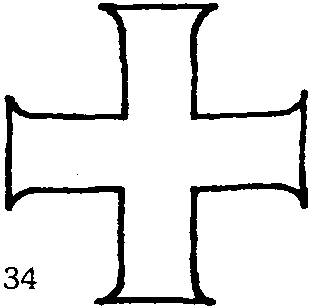
Rice. 34. Cross "Greek" or old Russian "korsunchik".
Traditional for Byzantium and the most frequently and widely used form of the so-called "Greek cross". The same cross is considered, as you know, the oldest "Russian cross", since, according to Church Tradition, the holy prince Vladimir took out from Korsun, where he was baptized, just such a cross (Fig. 34) and installed it on the banks of the Dnieper in Kyiv. A similar four-pointed cross has survived to this day in the Kiev Sophia Cathedral, carved on the marble board of the tomb of the prince Yaroslav, son of a saint Vladimir Equal-to-the-Apostles.
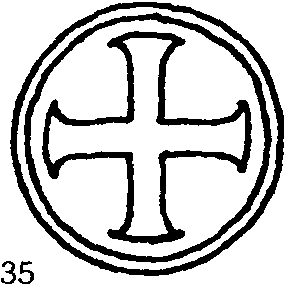
Rice. 35. Cross "Greek" or old Russian "korsunchik".
Often, to indicate the universal significance of the Cross of Christ as a microuniverse, the cross is depicted as inscribed in a circle, symbolizing the cosmological sphere of heaven (Fig. 35).
Cross "dome" with a crescent.
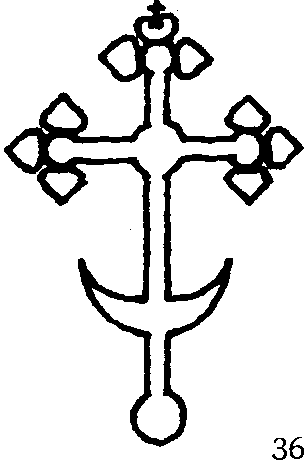
Rice. 36. Cross "dome" with a crescent.
It is not surprising that the question about the cross with a crescent is often asked, since the "dome" is located in the most prominent place. For example, the domes of the St. Sophia Cathedral of Vologda, built in 1570, are decorated with such crosses (Fig. 36).

Rice. 37. Cross "dome" with a crescent.
Typical of the pre-Mongol period, this form of a domed cross is often found in the Pskov region, such as on the dome of the Church of the Assumption of the Virgin in the village of Meletovo, erected in 1461 (Fig. 37).
In general, the symbolism of an Orthodox church is inexplicable from the point of view of aesthetic (and therefore static) perception, but, on the contrary, it is quite open for understanding precisely in liturgical dynamics, since almost all elements of church symbolism, in different places of worship, assimilate different meanings.
"And there appeared in heaven a great the Omen: wife clothed in the sun - says in Revelation John the theologian, under her feet moon" (Apoc. 12; 1), and patristic wisdom explains: this moon marks font, in which the Church, baptized into Christ, puts on Him, the Sun of righteousness.
The crescent is also cradle Bethlehem, which received the Divine Infant Christ; the crescent is bowl Eucharistic, in which the Body of Christ is located;
The crescent is ship church, led by the Feeder-Christ;
The crescent is anchor hope, the gift of the cross of Christ;
The crescent is also ancient serpent, trampled down by the Cross and placed as an enemy of God under the feet of Christ.
Cross "trefoil".
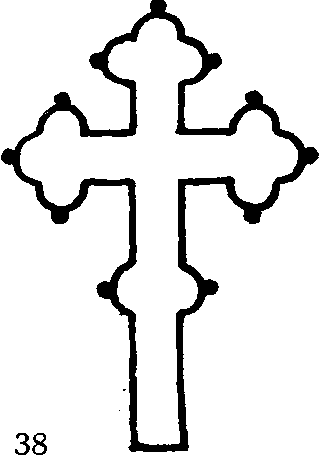
Rice. 38. Cross "trefoil".
In Russia, this form of the cross is used more often than others for the manufacture of altar crosses (Fig. 38). But, however, we can see it on state symbols. "Golden Russian shamrock cross, standing on a silver overturned crescent", as reported in the Russian Armorial, was depicted on the coat of arms of the Tiflis province (p. 191).
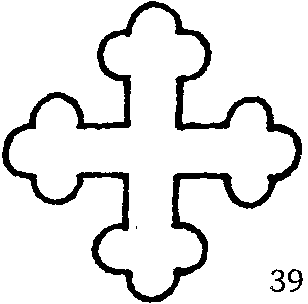
Rice. 39. Gold "shamrock" cross.
The golden “shamrock” (Fig. 39) is also on the coat of arms of the Orenburg province, on the coat of arms of the city of Troitsk, Penza province, the city of Akhtyrka, Kharkov and the city of Spassk, Tambov provinces, on the coat of arms of the provincial city of Chernigov, etc.
Cross "Maltese" or "George".
Patriarch Jacob prophetically honored the Cross when "I bowed down in faith, as the apostle says Paul, - on top of the wand his own"(Heb. 11:21), “rods,” the saint explains John Damascene - who served the image of the cross"(About the holy icons, 3 ate.).
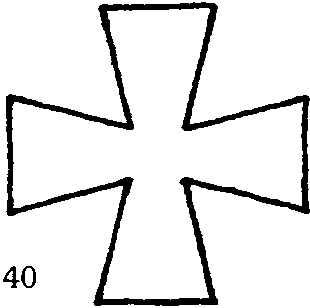
Rice. 40. Cross "Maltese" or "George".
That is why today there is a cross above the handle of the bishop's baton (Fig. 40), "for by the cross we- writes the saint Simeon Thessalonica, let us travel and feed, we are sealed, we have children, and, having mortified our passions, we are drawn to Christ.”(ch. 80). In addition to the usual and widespread church use, this form of the cross, for example, was officially adopted by the Order of St. John Jerusalem, formed on the island of Malta and openly fought against Freemasonry, which organized, as you know, the murder of the Russian Emperor Paul Petrovich - the patron saint of the Maltese. So the name appeared - "Maltese cross" (Fig. 40).
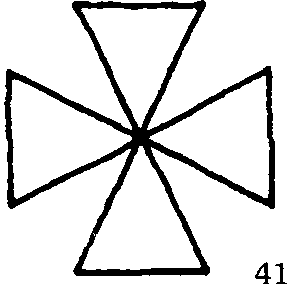
Rice. 41. Cross "Maltese" or "George".
![]()
Rice. 42. Cross "Maltese" or "George".

Rice. 43-44. Cross "Maltese" or "George".
According to Russian heraldry, some cities had golden “Maltese” crosses on their coats of arms, for example:
Zolotonosha (Fig. 40), Mirgorod (41) and Zenkov (41) of the Poltava province;
Pogar (40), Bonza (40) and Konotop (41) of the Chernihiv province;
Kovel (40) Volyn, Pavlovsk (44) St. Petersburg, Vindava (40) Courland, Belozersk (40) Novgorod provinces, Perm (42) and Elizabeth-Polish (43) provinces and others.
All those who were awarded the crosses of St. George Victorious (Fig. 43) of all four degrees, were called, as you know, "George's Cavaliers."
Cross "prosphora-Konstantinovsky".
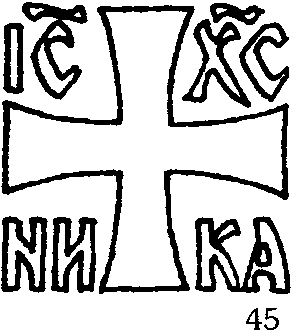
Rice. 45. Cross "prosphora-Konstantinovsky".
For the first time these words in Greek "IC.XP.NIKA", which means - "Jesus Christ is the Conqueror" were written in gold on three large crosses in Constantinople by the Equal-to-the-Apostles Emperor himself Constantine.
“To him who overcomes, I will grant to sit with me on my throne, just like I won and sat down with my Father on his throne."(Rev. 3; 21), says the Savior, Winner hell and death.
According to ancient tradition, an image of a cross is printed on the prosphora with the addition of words meaning this godmother. victory Christ's: "IS.CHR.NIKA". This "prosphora" seal (Fig. 45) means redemption of sinners from sinful captivity or, in other words, the great price of our Redemption.
Old-printed cross "wicker".

Rice. 46. Old-printed “wicker” cross.
"This weave is derived from ancient Christian art, - Professor V.N. Shchepkin authoritatively reports, - where it is known in carvings and mosaics. Byzantine weaving, in turn, passes to the Slavs, among whom it was especially common in the most ancient era in Glagolitic manuscripts.
(Textbook of Russian Paleography, Moscow, 1920, p. 51).
Rice. 47. Old-printed “wicker” cross.

Rice. 48. Old-printed “wicker” cross.

Rice. 49. Old-printed “wicker” cross.
Most often, images of "wicker" crosses (Fig. 46-49) are found as decorations in Bulgarian and Russian old printed books.
Cross "crystal".
White field lilies called in Slavonic "creen rural". In the book "Russian copper casting" we can see the pectoral "cross with crinoidal ends from Serensk XI-XII centuries. Such crosses are known in Byzantine antiquities of the 11th-12th centuries, and in the 14th-15th centuries they were widespread in Rus'” (M., 1993, p. 159).

Rice. 50. Cross "crystal".
In general, the symbolic image of the cross, consisting of flowers lilies(Fig. 50), recalls the words of the Savior about His ministry: "I, says the Lord — lily valleys!"(Song 2; 1).
“For my sake, who is in the valley, He descends into the valley,— writes Origen about Christ, and, having come into the valley, it is done lily. Instead of the tree of life, which was planted in the paradise of God, He became flower the whole field, that is, the whole world and the whole earth".
"Hear Me, Pious Children, calls all the Word of God, bloom like lily» (Sirach 39; 16-18), that is, in other words, with a wise and pious life, be pure incense to the All-Perfect.
The cross is four-pointed "drop-shaped".
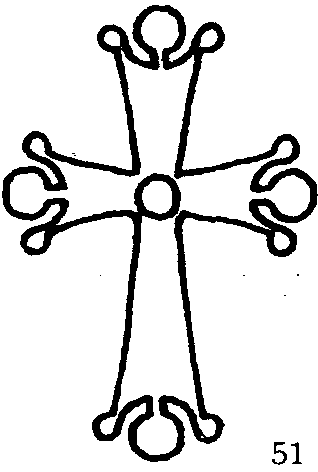
Rice. 51. Four-pointed "drop-shaped" cross.
Sprinkling the cross tree, blood drops Christ forever communicated His power to the cross.
The Greek Gospel of the 2nd century from the State Public Library opens with a leaf depicting a beautiful "teardrop"(Fig. 51) of a four-pointed cross (Byzantine miniature, M., 1977, pl. 30).

Rice. 52. Four-pointed "drop-shaped" cross.
And also, for example, we recall that among the copper pectoral crosses cast in the first centuries of the second millennium, as is known, there are often "drop-shaped"(fig. 52) encolpions (in Greek - “on the chest").
At the beginning of Christ "drops of blood, falling to the ground"(Luke 22; 44), became a lesson in the fight against sin even "before blood» (Heb. 12; 4); when on the cross from Him "expired blood and water"(John 19; 34), then by example they were taught to fight evil even to death.
"To him(Savior) who loved us and washed us from our sins blood My own"(Rev. 1; 5), who saved us « the blood of the cross His"(Col. 1; 20) - Glory forever!
Cross "crucifixion".
One of the first images of the crucified Jesus Christ that has come down to us belongs only to the 5th century, on the doors of the church of St. Sabina in Rome.
WITH 6th century The Savior began to be depicted in a long robe of a collobia - as if leaning against a cross. It is this image of Christ that can be seen on the early bronze and silver crosses of Byzantine and Syrian origin of the 17th-9th centuries.
6th century saint Anastasy Sinai wrote an apologetic (in Greek - "defence") essay "Against the acephalus" - a heretical sect that denies the unity of two natures in Christ. To this essay he attached an image of the crucifixion of the Savior as argument against monophysitism . He conjures the copyists of his work, together with the text, to transfer inviolably the image attached to it, as, by the way, we can see on the manuscript of the Vienna Library.
Another, even more ancient surviving image of the crucifixion is on the miniature of the Ravvula Gospel from the Zagba monastery. This 586 manuscript belongs to the Florentine Library of St. Lawrence.
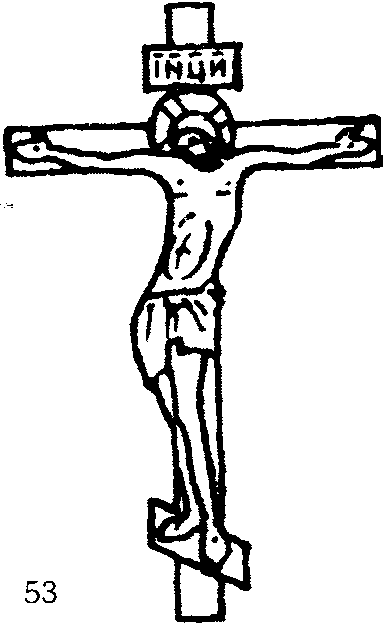
Rice. 53. Cross "crucifixion".
Until the 9th century inclusive, Christ was depicted on the cross not only alive resurrected, but also triumphant(Fig. 53) - and only in the 10th century did images appear dead Christ(Fig. 54).
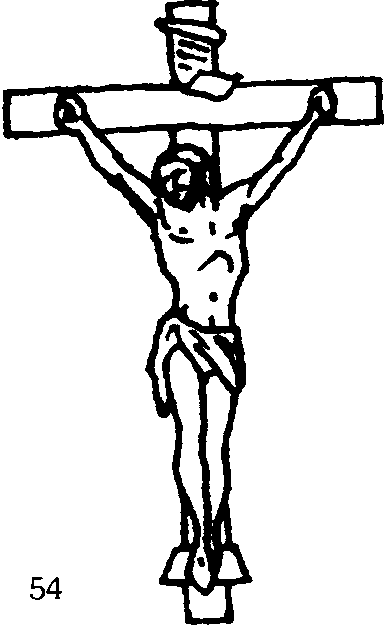
Rice. 54. Cross "crucifixion".
From ancient times, crucifixion crosses, both in the East and in the West, had a crossbar to support the feet of the Crucified, and His feet were depicted as nailed each separately with his nail (Fig. 53). The image of Christ with crossed feet, nailed with one nail (Fig. 54), first appeared as an innovation in the West in the second half of the 13th century.
Greek letters were necessarily written on the cross-shaped halo of the Savior OΩN, meaning "true Existing» , because "God said to Moses: I am Existing» (Ex. 3; 14), thereby revealing His own name, expressing the self-existence, eternity and immutability of the being of God.
From Orthodox dogma Cross(or atonement) undoubtedly follows the idea that the death of the Lord is redemption of all, calling of all peoples. Only cross, unlike other executions, gave Jesus Christ the opportunity to die with outstretched arms, calling"all ends land"(Isaiah 45; 22).
Therefore, in the tradition of Orthodoxy - to portray the Savior All-holder just like the Risen One cross bearer, holding and calling to Your embrace the whole universe and bearing on himself the New Testament altar is the Cross (Fig. 53). The prophet spoke about this Yersmia on behalf of the Christ-haters: "Let us put wood into His bread"(11; 19), that is, the tree of the cross put on the body Christ, called the bread of heaven (St. Dimitri Height. cit. op.).
A traditionally Catholic image of the crucifixion, with sagging in the arms of Christ (Fig. 54), on the contrary, has the task of showing what How it all happened, depict dying suffering and death and not at all What is essentially the eternal Fruit of the Cross—His triumph.
Orthodoxy invariably teaches that all sinners suffering necessary for the humble assimilation by them the Fruit of Redemption - the Holy Spirit, sent by the sinless Redeemer, which, out of pride, the papers do not understand, their sinful suffering seeking participation in sinless, and therefore redemptive Passion of Christ and thereby falling into the Crusaders' heresy of "self-salvation."
Schematic cross or "Golgotha".
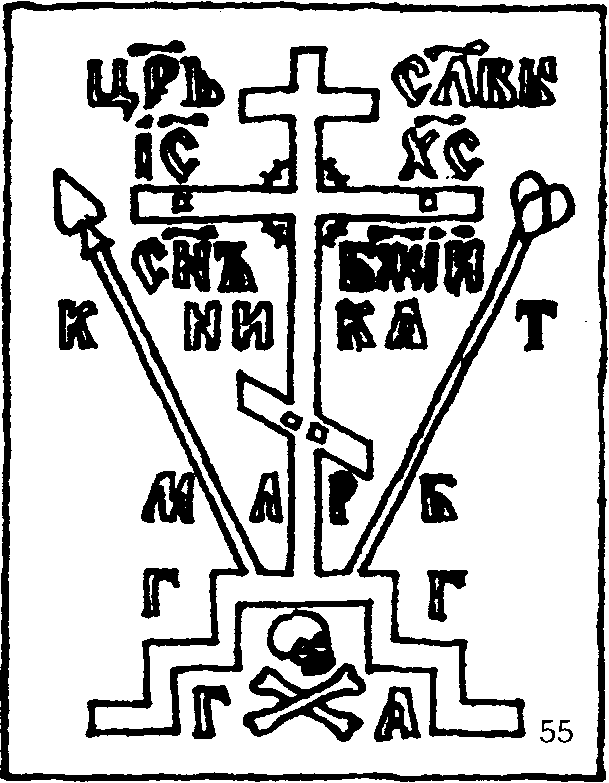
Rice. 55. Schematic cross or "Golgotha".
The inscriptions and cryptograms on Russian crosses have always been much more diverse than on Greek ones.
Since the 11th century, under the lower oblique crossbar of the eight-pointed cross, a symbolic image of the head of Adam appears, who, according to legend, was buried on Golgotha. (in Hebrew -"frontal place"), where Christ was crucified. “In the place where I will be buried, the Word of God will be crucified and sprinkle my skull with His blood” Adam prophesied. These words of his clarify the tradition that had developed in Rus' by the 16th century to produce the following designations near the image of "Golgotha":
« M.L.R.B."- the place of the frontal was crucified," G.G."- Mount Golgotha," G.A." - the head of Adamov; moreover, the bones of the hands lying in front of the head are depicted: right on the left, as during burial or communion.
Letters " TO" And " T» mean copy centurion of Longinus and cane with a sponge, depicted along the cross.
The inscriptions are placed above the middle crossbar: " IC» « XC"- the name of Jesus Christ;
and below it: "NIKA"— Winner;
on the title (plate) or near it the inscription: "SN" "BZHIY" - Son of God or abbreviation "I.N.Ts.I."- Jesus of Nazareth King of the Jews;
the inscription above the title: "TSR" "WORDS" - King of Glory.
Such crosses are supposed to be embroidered on the vestments of the great and angelic schema;
three crosses on the paraman and five on the kukul: on the forehead, on the chest, on both shoulders and on the back.
Cross "Calvary"(Fig. 55) is also depicted on the funeral shroud, which marks the preservation of the vows given at baptism, like the white shroud of the newly baptized, meaning cleansing from sin.
Unlike cross image, depicting directly the Crucified Christ Himself, the sign of the cross conveys his spiritual meaning, depicts his real meaning, but the Cross itself does not show.
“The Cross is the guardian of the entire universe, the Cross is the beauty of the Church, the Cross is the power of the kings, the Cross is the faithful affirmation, the Cross is the glory of the angel, the Cross is the plague of the devil” , - affirms the absolute Truth of the luminaries of the feast of the Exaltation of the Life-Giving Cross.
Cross "gamma", in the West "crux gammata".
"God of the armies of heaven and earth,- exclaims the saint Filaret Moscow, — With your help the prophet who defeated the enemies is not without your beckoned, he erected a monument to victory and called it "a stone help» (1 Sam. 7; 12). Here is a monument, no doubt blessed and sacred, because it blesses and hallows the name Lord Helper. "Bless,- asks the saint of the Lord, - a monument not only to the courage and victories of Christ-loving Russian soldiers, but also Your help by which they are victorious and invincible"(Words and speeches, M., 1877, vol. 3, p. 130; Words and speeches, M., 1885, vol. 5, p. 14).
But do monuments glorify Christ the Redeemer, trampling underfoot His holy Cross? Are the sculptors worthy of God's blessing who forced the Russian warriors - Alyosha the Liberator, Marshal Zhukov and others - to trample on His Cross?
According to the 73rd canon of the Fifth-Sixth Ecumenical Council, All, Who depicts a cross where it is May be trample on feet, betray curse and excommunicate from the Church: “Inasmuch as the life-giving Cross has shown us salvation, then it is fitting for us to use every diligence, so that due honor will be rendered to the one through which we are saved from the ancient fall. Therefore, in thought, and in word, and in feeling, bringing worship to him, we command: the image of the cross, drawn by some on earth, should be completely blotted out, so that the sign of our victory would not be insulted by trampling walking. And so, from now on, we command those who draw the image of the cross on the ground excommunicate» .
It is useful for everyone, and especially Christians, to know and never forget that the Universal Church of Christ has been using the gamma form of the cross for two thousand years and that "Cross any forms,- as the saint teaches Theodore Studit - There is true Cross"!
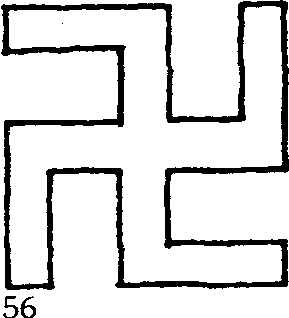
Rice. 56. Cross "gamma", in the West "crux gammata".
From well-known ecclesiastical and secular specialists in history and archeology, one can learn that among different forms cross "the form was also in use gammatic cross (Fig. 56), consisting of(Greek letter) gamma", - according to the archimandrite Gabriel in the book "Guide to Liturgy, or the Science of Orthodox Worship, for Theological Seminaries", editions of 1886 in Tver (p. 344).
And from the book "Christian Symbolism" Count A.S. Uvarov, you can find out that the gamma cross is depicted on a chalice (a vessel for communion) as early as the 4th century (p. 36).
In the album "Byzantine miniature" you can read that in the 9th century, by order of the empress Theodora in the imperial scriptorium, a Gospel was made, decorated with a gold ornament of gamma crosses, with elements of the antique meander ornament (M., 1977, p. 13, tab. 4).

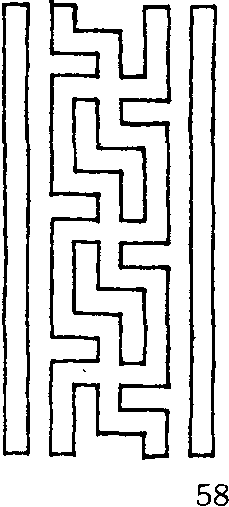
Rice. 58. Cross "gamma", in the West "crux gammata".
![]()
Rice. 60. Cross "gamma", in the West "crux gammata".
And in the album V.N. Lazarev, you can see the ornament from the gamma cross, which is decorated with:
and the arches of the Hosios Lucas monastery in the 11th century (Fig. 58), and the apse of the Cathedral of St. Sophia of Kiev in the 11th century (Fig. 60), and the walls of the Church of St. George in Kurbinovo in the 12th century (Fig. 61) , and the western wall of the Istanbul Kahriye Jami of the beginning of the 14th century (Fig. 59) (Tables, M., 1986, Fig. 156, 170, 350, 469), as well as bishop's vestments of the Byzantine period and many frescoes in the Balkans (Fig. 57).
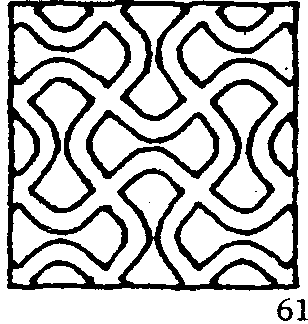
Rice. 61. Cross "gamma", in the West "crux gammata".

Rice. 59. Cross "gamma", in the West "crux gammata".

Rice. 57. Cross "gamma", in the West "crux gammata".
And in the book "Matenadaran" a four-pointed cross is depicted surrounded
twelve gamma crosses, where next it is explained that: “illustrations of the Etchmiadzin Gospel reflect transformative connection two testaments, affirming the most important dogmas Christianity"(p. 30).
The Old Testament altar, being a transformation of the New Testament altar - the Cross of Christ, had horns installed at four ends, which were anointed with sacrificial lamb blood, which was a type of the blood of Christ, who was coming to shed it on the Cross. Not only the deep connection of the two Testaments, but also their essential difference was noted by the Apostle: “every (Old Testament) the priest stands daily in service and repeatedly brings the same sacrifices that can never take away sins. He is(Christ), bringing one sacrifice for sins, sat forever at the right hand of God, wrote Paul, -for He one made perfect those who are being sanctified by the offering"(Heb. 10; 11-14).
One Byzantine emperor, wanting to express his anti-Christian policy more precisely, said bluntly: I am fighting against the Cross! And now the servants of the Antichrist - the haters of the Cross and the Crusaders - are again aiming at the Holy Cross.
By Yeltsin's decree of March 23, the Russian Academy of Sciences prepared a document "On the Essence and Signs of Fascism" , which also talks about fascist symbols, but there is not a word about the essence and signs of this symbolism. This document quite suited the President, who instantly signed the draft of a new "law", which, in particular, says:
“Article 229 shall be stated in the following wording: (…) desecration fascist symbolism and paraphernalia (...) is punishable by imprisonment for up to five years with confiscation” (Rossiyskaya Gazeta, June 21, 1995). Thus, it is “legitimized” that the image of the cross “defiles”!
Indeed, there is no way to recognize fascist symbols hundreds of images of the gamma cross among Christians, for example:
cast and engraved on church utensils of the pre-Mongolian period;
mosaic under the dome of the Cathedral of St. Sophia in Kyiv;
icon-painting - on the vestments of the Byzantine Saints;
relief ornament around the doors of the Nizhny Novgorod Cathedral;
embroidered on the phelonion of the Moscow Church of St. Nicholas, in Pyzhi, and so on.
Why did the Shamballist Sighs slip the demon-possessed Fuhrer Hitler a “gamma”? - this is a third-rate question; although, judging by the fruits, the Holy Cross, which sanctifies the entire universe, is today called by the “law” (forgive me, Lord!) “a defiling symbol”, and such attacks, as is well known, end badly. "For many, Apostle warns Paul, - act like enemies of the cross Christ. Their end is death."(Phil. 3; 18-19). The cross was given to the Church as a banner of the victory of the kingdom of grace over the kingdom of sin and therefore let the mouths of the blasphemers of the Cross be stopped by the power of Jesus Christ crucified on it!
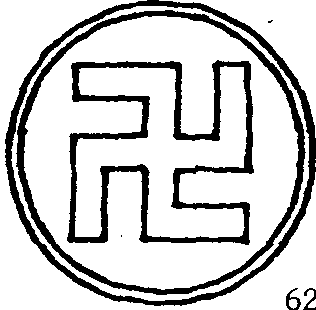
Rice. 62. Cross "gamma", in the West "crux gammata".
Already the first Christians in the Roman catacombs depicted a gamma cross, which in many Indo-European peoples corresponded to the concept of "eternity" or "happiness" and was called "swastika".
Pyotr Andreevich Zhilliard, according to the protocols from the case of N. A. Sokolov, explained the reason for the widespread use by Empress Alexandra Feodorovna of gamma crosses, “which Her Majesty used to put often on her things as a sign of well-being ... She did them like this: (N. Ross , Death of the Royal Family, Frankfurt am Main, 1987, p. 235).
For example, on the hood of the tsarist car (as can be seen in the photo above), a gamma cross was installed in a vertical position (Fig. 62). The Empress also drew it with a black pencil in the Ipatiev house: both on the wallpaper by her bed and on the door frame with the inscription “April 17/30 (Firs) 1918”, the day the Royal Family arrived in Yekaterinburg.
mystically this form of the cross reflects the whole mystery of God's Providence, and dogmatically it expresses the fullness of the Church's doctrine.
Another patriarch Jacob received a mystical vision "stairs standing on the ground and reaching to the sky", two parts of which, intersecting, formed Cross, by which the earthly is now freely united with the heavenly, man with God; and on the steps of which "angels God's ascend and descend » (Gen. 28; 12), signifying with the cross the unceasingness of God's saving care and providential protection of man. After all, in this "a world lying in evil"(1 John 5; 19), only Cross gives a pure concept of the victorious presence of God everywhere and leads a person "a new and living way"(Heb. 10; 19) straight to Heaven; the cross center of which is the place of meeting and reconciliation of creatures and the Creator. The God-man Jesus Christ, explaining the mystical side of the cross, said that "from now on you will see heaven open and the angels of God ascending and descending to the Son of Man"(John 1; 51), in other words, looking at the sign of the cross they will mentally "ascend", reflecting on His (Savior's) Divine nature, and "descend", contemplating His incarnation and descent into hell.

Rice. 11. Cross "Burgundy" or "Andreevsky".
Ladder Jacob resembling an X-shaped "Burgundy" cross (Fig. 11), is a mystical indication of two paths, from Heaven to earth and from earth to Heaven:
first - leaving the Father by the Son-Groom for the sake of descending to the Church-Bride, and second - taking Her as a Wife and returning with Her to the house of the Father.
Apostle Paul,“kneeling before the Father” (Eph. 3; 14) Heavenly, prays for the affirmation of the faithful in love, so that "could comprehend with all the saints, what is) latitude and longitude, and depth and height » (Eph. 3; 18)! With a saint John Damascus can comprehend that this is a symbol of God's Almighty - the Cross: "Like the four ends cross are held together and united by its center, and by the power of God holding on height and depth, longitude and breadth, that is, all visible and invisible creation ”(Exact presentation of the Orthodox faith, book 4, ch. 11).
And with the saint Dimitri Rostovsky, we can comprehend that this is the power of the Cross over all three levels of being: “The image of the cross (...) by the middle intersection shows that everything is contained by Divine power; all heavenly top the end contains the underworld with the lower, and all the earthly with the two ends holy tree of the cross. (…) Marking with height heavenly, the depth underworld, latitude and longitude earthly, the contents of the all-powerful power of the Cross ”(Search, book 2, ch. 24).
Symbolic image of a cruciform staircase, from the vision of the patriarch Jacob in combination with the three levels of the existence of the Church (from the prayer of the Apostle Paul) will help to penetrate the secret of the dogmatic content of both parts (Fig. 63), at the intersection forming a gamma cross.
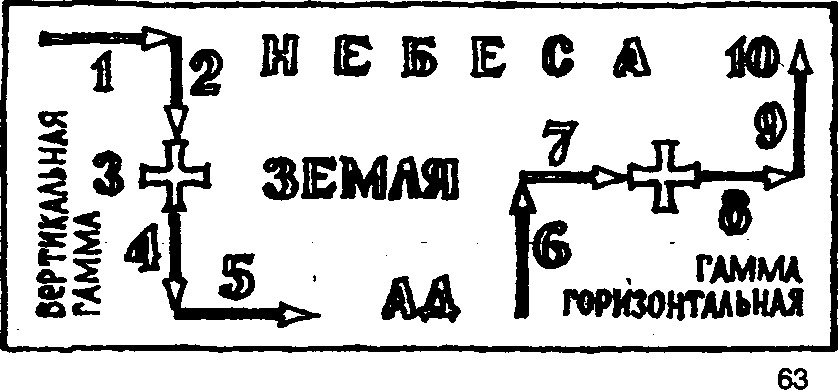
Rice. 63. Cross "gamma", in the West "crux gammata".
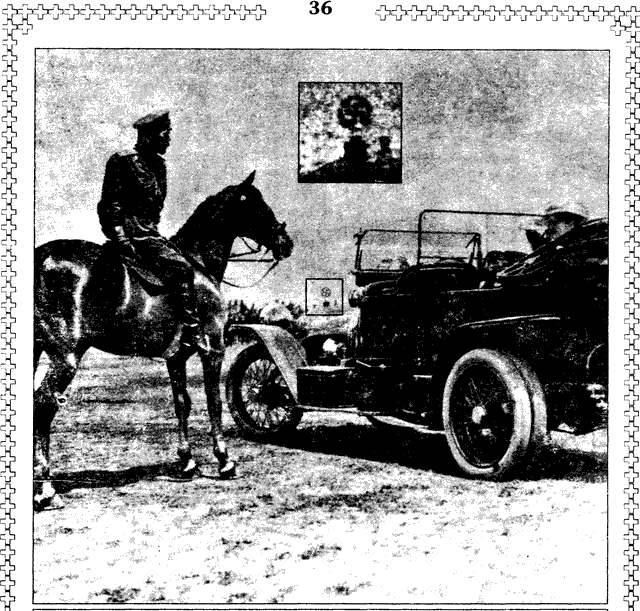
In the Foto:
Sovereign Nikolai Alexandrovich on horseback and Empress Alexandra Feodorovna in her car, on the hood of which there is a gamma cross in a circle installed by order of Her Majesty.
Cross card "shamrock", spear, sponge and nail.
The motives for the outrageous desecration and blasphemy of the Holy Cross by conscious crusaders and crusaders are quite understandable. But when we see Christians drawn into this heinous deed, all the more so it is impossible to remain silent, for - according to the word of the saint Vasily Great - “God is given up in silence”!
So called "playing cards" which, unfortunately, are found in many homes, is an instrument of non-communication, by means of which a person certainly comes into contact with demons - the enemies of God. All four cards "suits" mean nothing more than the cross of Christ, along with other sacred objects equally revered by Christians: spear, sponge And nails, that is, all that was the instruments of suffering and death of the Divine Redeemer. And out of ignorance, many people, throwing themselves "to the fool" , allow themselves blaspheme the Lord taking, for example, a card with a cross "shamrock", that is, the cross of Christ, which half the world worships, and, throwing it casually with the words (forgive me, Lord!) "club", what is translated from Yiddish means "bad" or "evil spirits"! Moreover, these daredevils, who played suicide, essentially believe that this cross "beats" some lousy "trump six", not at all knowing that "trump" And "kosher" it is written, for example, in Latin, the same way. It would be high time to clarify the true rules of all card games, in which "in the fools" remain All playing: they consist in the fact that ritual sacrifices, in Hebrew called Talmudists "kosher"(that is "clean"), allegedly have power over the Life-Giving Cross! If you know that playing cards cannot be used for other purposes than desecration of Christian shrines to the delight of demons , then the role of maps in "fortune-telling"— these vile quests for demonic revelations. In this regard, is it necessary to prove that anyone who has touched a deck of cards and has not brought sincere repentance in confession for the sins of blasphemy and blasphemy has a guaranteed registration in hell?
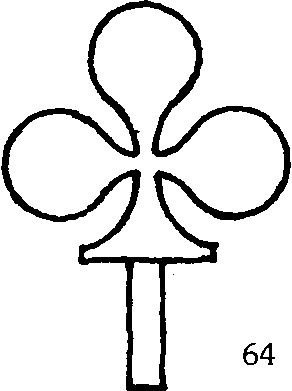
Rice. 64. Cross card "trefoil" - "clubs", otherwise "cross".
So if "clubs"- this is the blasphemy of raging gamblers on specially depicted crosses(Fig. 64), also called them "baptize", then what do they mean - "blame", "worms" And "diamonds"? We will not bother translating these curses into Russian, since we do not have a textbook Yiddish; better to open New Testament to shed on the demonic tribe the unbearable Light of God for them.
saint Ignatius Brianchaninov edifies in the imperative mood: "check out with the spirit of the times learn him, so that if possible avoid his influence” (Otech. p. 549).
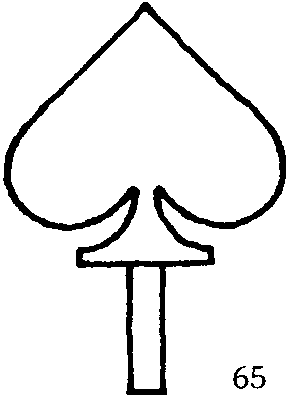
Rice. 65. Card suit “blame”, or otherwise - “spades”.
card suit "blame" or otherwise "peaks" blasphemes the gospel pike(fig. 65), i.e. a spear holy martyr Longina centurion. As he predicted about his perforation Lord, by the mouth of the prophet Zechariah What "They will look to the one who pierced» (12; 10), this is what happened: one of the warriors(longin) pierced with a spear He has ribs"(John 19; 34).
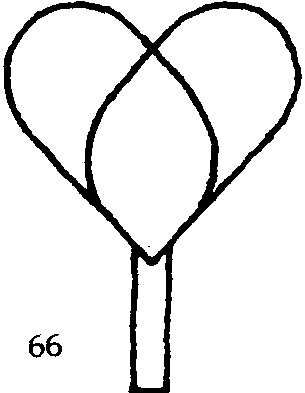
Rice. 66. Card suit "worms", otherwise - "sponge on a cane."
card suit "worms" blasphemes the gospel sponge(rice. 66) on canes. As he warned about his poisoning Christ, through the mouth of the king-prophet David that the warriors "Give Me food bile, and in my thirst they gave me drink vinegar» (Ps. 68; 22), and so it came true: one of them took sponge, got drunk vinegar and putting on cane, gave him a drink" (Mt. 27; 48).

Rice. 67. Card suit "tambourines", otherwise - "four-sided jagged nails."
card suit "diamonds" blasphemes gospel forged square serrated nails(Fig. 67), with which the hands and feet of the Savior were nailed to the tree of the Cross. As the Lord prophesied about his nail crap, through the mouth of the psalmist David What « pierced My hands and My feet(Ps. 22; 17), and so it was fulfilled: Apostle Thomas, who said "if not I will see on the hands of His wounds from nails, and I will not put my finger into the wounds of nails, and I will not put my hand in ribs I don't believe him"(John 20; 25), "I believed because I saw"(John 20; 29); and Apostle Peter, Addressing his fellow tribesmen, he testified: "Men of Israel! — he said, Jesus of Nazareth (…) you took and, nailing (to the cross) hands(Romans) lawless, killed; but God raised him up"(Acts 2; 22, 24). The unrepentant thief crucified with Christ, like today's gamblers, blasphemed the sufferings of the Son of God on the Cross and, out of arrogance, out of impenitence, went to hell forever; but the prudent thief, setting an example for all, repented on the cross and thereby inherited eternal life with God blessing. Therefore, let us firmly remember that for us Christians there can be no other object of hope and hope, no other support in life, no other banner that unites and inspires us, except for the only saving sign. invincible cross Lord!
Moscow, March-April 1997
Introduction ………………….…………………………………………….3
- Cross T-shaped "Antonievskiy" ..……………………….…..5
- Cross "Egyptian hieroglyph Ankh".……………………………7
- Cross "letter" ………….……………………………………..7
- Cross "anchor-shaped" ………………………………………………7
- Cross monogram "pre-Konstantinovsky" ……………………..8
- Cross-monogram "shepherd's staff" … …………………………8
- Cross "Burgundy" or "Andreevsky" …………………………9
- Cross “Monogram of Constantine” ……………………………….10
- Monogram cross “Post-Konstantinovsky” ………………11
- Cross monogram "sun-shaped" …………..………….12
- Cross monogram "trident".……………………………12
- Cross monogram "Konstantinovsky" ………….…………13
- Cross round "swallow" ….……………………………….13
- Catacomb cross or “sign of victory” …………..………14
- The cross in Rus' is “patriarchal” or in the West “Lorensky” ....15
- Four-pointed cross or Latin “immissa” …………..16
- Cross “papal” ………….………………………………………16
- Six-pointed cross "Russian-Orthodox" …………….17
- Orthodox octagonal cross …………….…………..18
- Seven-pointed cross ……………………………..……………18
- Cross “crown of thorns” …….…………………………………20
- Cross "gallows" …..………………………………..21
- Cross “vine” ……………………………………..21
- Cross “petal” ……………………………………..…….22
- Cross "Greek" or old Russian "korsunchik" ..….….22
- Cross "dome" with a crescent moon ………………………..23
- Cross "trefoil" …….……………………………..….23
- Cross "Maltese" or "George" …………..……..…..24
- Cross "prosphora-Konstantinovsky" ………….……..…….25
- Old-printed cross “wicker”……………………..……..25
- Cross "crinoid" …………………………………..………26
- Cross four-pointed "drop-shaped" ……………………….27
- Cross “crucifixion” ………..………………………………..……..27
- Schema Cross or “Golgotha”……………………..…..29
- Cross "gamma", in the West "crux gammata" …….…….30
- Cross card "shamrock", spear, sponge and nail……….36
Among all Christians, only Orthodox and Catholics venerate crosses and icons. They decorate the domes of churches, their houses with crosses, they wear them around the neck.
The reason why a person wears pectoral cross, to each his own. Someone thus pays tribute to fashion, for someone the cross is a beautiful piece of jewelry, for someone it brings good luck and is used as a talisman. But there are also those for whom the pectoral cross worn at baptism is indeed a symbol of their infinite faith.
Today shops and church shops offer big variety crosses of various shapes. However, very often, not only parents who are going to baptize a child, but also sales assistants cannot explain where the Orthodox cross is and where the Catholic one is, although it is actually very simple to distinguish them.IN Catholic tradition- a quadrangular cross, with three nails. In Orthodoxy, there are four-pointed, six-pointed and eight-pointed crosses, with four nails for hands and feet.
cross shape
four-pointed cross
So, in the West, the most common is four-pointed cross. Starting from the III century, when such crosses first appeared in the Roman catacombs, the entire Orthodox East still uses this form of the cross as equal to all others.
For Orthodoxy, the shape of the cross does not really matter, much more attention is paid to what is depicted on it, however, eight-pointed and six-pointed crosses have received the greatest popularity.
Eight-pointed Orthodox cross most corresponds to the historically reliable form of the cross on which Christ was already crucified.The Orthodox cross, which is most often used by the Russian and Serbian Orthodox churches, contains, in addition to a large horizontal bar, two more. The top symbolizes the tablet on the cross of Christ with the inscription "Jesus the Nazarene, King of the Jews"(INCI, or INRI in Latin). The lower slanting crossbar - a prop for the feet of Jesus Christ symbolizes the "righteous measure", weighing the sins and virtues of all people. It is believed that it is tilted to the left side, symbolizing that the repentant robber, crucified on the right side of Christ, (first) went to heaven, and the robber, crucified on the left side, by his blasphemy of Christ, further aggravated his posthumous fate and ended up in hell. The letters IC XC are a Christogram symbolizing the name of Jesus Christ.
Saint Demetrius of Rostov writes that "when Christ the Lord on His shoulders wore the cross, then the cross was still four-pointed; because there was still no title or foot on it. There was no foot, because Christ on the cross and the soldiers had not yet been raised, not knowing where the legs would reach Christ's, did not attach a footstool, having finished it already at Calvary". Also, there was no title on the cross before the crucifixion of Christ, because, as the Gospel reports, first they “crucified Him” (John 19:18), and then only “Pilate wrote an inscription and placed it on the cross” (John 19:19 ). It was at first that the warriors “who crucified Him” (Mt. 27:35) divided “His clothes” by lot, and only then “They put an inscription over His head, signifying His guilt: This is Jesus, the King of the Jews”(Matthew 27:37).
The eight-pointed cross has long been considered the most powerful protective tool against various kinds of evil spirits, as well as visible and invisible evil.
six pointed cross
Widespread among Orthodox believers, especially during Ancient Rus', also had six-pointed cross . It also has an inclined crossbar: the lower end symbolizes unrepentant sin, and the upper end symbolizes liberation by repentance.
However, not in the shape of the cross or the number of ends lies all its power. The cross is famous for the power of Christ crucified on it, and all its symbolism and miraculousness lies in this.
The variety of forms of the cross has always been recognized by the Church as quite natural. In the words of the Monk Theodore the Studite - "a cross of every form is a true cross" Andhas unearthly beauty and life-giving power.
“There is no significant difference between Latin, Catholic, Byzantine, and Orthodox crosses, as well as between any other crosses used in the service of Christians. In essence, all crosses are the same, the differences are only in form., - says the Serbian Patriarch Irinej.
crucifixion
In the Catholic and Orthodox Churches special meaning attached not to the form of a cross, but to the image of Jesus Christ on it.
Until the 9th century inclusive, Christ was depicted on the cross not only alive, resurrected, but also triumphant, and only in the 10th century did images of the dead Christ appear.
Yes, we know that Christ died on the cross. But we also know that He later resurrected, and that He suffered voluntarily out of love for people: to teach us to take care of the immortal soul; so that we too can be resurrected and live forever. In the Orthodox Crucifixion, this Paschal joy is always present. Therefore, on the Orthodox cross, Christ does not die, but freely stretches out his hands, the palms of Jesus are open, as if he wants to embrace all of humanity, giving them his love and opening the way to eternal life. He is not a dead body, but God, and his whole image speaks of this.
The Orthodox cross above the main horizontal bar has another, smaller one, which symbolizes the tablet on the cross of Christ indicating the offense. Because Pontius Pilate did not find how to describe the guilt of Christ, the words appeared on the tablet "Jesus of Nazareth King of the Jews" in three languages: Greek, Latin and Aramaic. In Latin in Catholicism, this inscription looks like INRI, and in Orthodoxy - IHCI(or ІНHI, “Jesus of the Nazarene, King of the Jews”). The lower oblique crossbar symbolizes a leg support. It also symbolizes two thieves crucified to the left and right of Christ. One of them repented of his sins before his death, for which he was awarded the Kingdom of Heaven. The other, before his death, blasphemed and reviled his executioners and Christ.
Above the middle crossbar are the inscriptions: "IC" "XS"- the name of Jesus Christ; and below it: "NIKA" — Winner.
Greek letters were necessarily written on the cross-shaped halo of the Savior UN, meaning - "Truly Existing", because "God said to Moses: I am who I am"(Ex. 3:14), thereby revealing His name, expressing the self-existence, eternity and immutability of the being of God.
In addition, the nails with which the Lord was nailed to the cross were kept in Orthodox Byzantium. And it was precisely known that there were four of them, not three. Therefore, on Orthodox crosses, the feet of Christ are nailed with two nails, each separately. The image of Christ with crossed feet, nailed with one nail, first appeared as an innovation in the West in the second half of the 13th century.
In the Catholic Crucifixion, the image of Christ has naturalistic features. Catholics depict Christ as dead, sometimes with streams of blood on his face, from wounds on his arms, legs and ribs ( stigmata). It manifests all human suffering, the torment that Jesus had to experience. His arms sag under the weight of his body. The image of Christ on the Catholic cross is plausible, but this image of the dead man, while there is no hint of the triumph of victory over death. The crucifixion in Orthodoxy just symbolizes this triumph. In addition, the feet of the Savior are nailed with one nail.
Meaning death on the cross Savior
emergence christian cross connected with the martyrdom of Jesus Christ, which he accepted on the cross at the forced verdict of Pontius Pilate. Crucifixion was a common form of execution in Ancient Rome, borrowed from the Carthaginians - the descendants of the Phoenician colonists (it is believed that the crucifix was first used in Phoenicia). Usually thieves were sentenced to death on the cross; many early Christians, persecuted since the time of Nero, were also executed in this manner.
Before the sufferings of Christ, the cross was an instrument of shame and terrible punishment. After His suffering, he became a symbol of the victory of good over evil, of life over death, a reminder of the infinite God's love, a subject of joy. The incarnated Son of God sanctified the cross with His blood and made it a vehicle of His grace, a source of sanctification for believers.
From the Orthodox dogma of the Cross (or Atonement), the idea undoubtedly follows that the death of the Lord is the ransom of all, the calling of all peoples. Only the cross, unlike other executions, made it possible for Jesus Christ to die with outstretched arms calling "to all the ends of the earth" (Isaiah 45:22).
Reading the Gospels, we are convinced that the feat of the Cross of the God-man is the central event in His earthly life. By His sufferings on the Cross, He washed away our sins, covered our debt to God, or, in the language of Scripture, "redeemed" us (ransomed us). In Golgotha lies the incomprehensible mystery of the infinite truth and love of God.
The Son of God voluntarily took upon Himself the guilt of all people and suffered for it a shameful and most painful death on the cross; then on the third day he rose again as the conqueror of hell and death.
Why was such a terrible Sacrifice needed to cleanse the sins of mankind, and was it possible to save people in another, less painful way?
The Christian doctrine of the death of the God-man on the cross is often a "stumbling block" for people with already established religious and philosophical concepts. As many Jews as people Greek culture In apostolic times, it seemed contradictory to assert that the almighty and eternal God descended to earth in the form of a mortal man, voluntarily endured beatings, spitting and shameful death, that this feat could bring spiritual benefit to mankind. "This is impossible!"- objected one; "It is not necessary!" others argued.
The Holy Apostle Paul in his epistle to the Corinthians says: “Christ sent me not to baptize, but to preach the gospel, not in the wisdom of the word, so as not to abolish the cross of Christ. For the word of the cross is foolishness for those who are perishing, but for us who are being saved, it is the power of God. Where is the wise man, where is the scribe, where is the questioner of this world? Has not God turned the wisdom of this world into foolishness? and the Greeks seek wisdom; but we preach Christ crucified, for the Jews a stumbling block, and for the Greeks foolishness, for the very called ones, Jews and Greeks, Christ, God's power and God's wisdom"(1 Corinthians 1:17-24).
In other words, the apostle explained that what in Christianity was perceived by some as temptation and madness, is in fact the work of the greatest Divine wisdom and omnipotence. The truth of the atoning death and resurrection of the Savior is the foundation for many other Christian truths, for example, about the sanctification of believers, about the sacraments, about the meaning of suffering, about virtues, about achievement, about the goal of life, about the coming judgment and resurrection of the dead and others.
At the same time, the redemptive death of Christ, being an event inexplicable in terms of earthly logic and even "seductive for those who perish," has a regenerating power that the believing heart feels and strives for. Renewed and warmed by this spiritual power, both the last slaves and the most powerful kings bowed with trepidation before Golgotha; both dark ignoramuses and the greatest scientists. After the descent of the Holy Spirit, the apostles personal experience became convinced of the great spiritual blessings brought to them by the atoning death and resurrection of the Savior, and they shared this experience with their disciples.
(The mystery of the redemption of mankind is closely connected with a number of important religious and psychological factors. Therefore, in order to understand the mystery of the redemption, it is necessary:
a) to understand what actually is the sinful damage of a person and the weakening of his will to resist evil;
b) it is necessary to understand how the devil's will, thanks to sin, got the opportunity to influence and even captivate the human will;
c) one must understand the mysterious power of love, its ability to positively influence a person and ennoble him. At the same time, if love reveals itself most of all in sacrificial service to one's neighbor, then there is no doubt that giving one's life for him is the highest manifestation of love;
d) from understanding strength human love one must rise to the understanding of the power of Divine love and how it penetrates the soul of the believer and transforms his inner world;
e) in addition, in the atoning death of the Savior there is a side that goes beyond human world, namely: On the cross there was a battle between God and the proud Dennitsa, in which God, hiding under the guise of weak flesh, emerged victorious. The details of this spiritual battle and Divine victory remain a mystery to us. Even Angels, according to ap. Peter, do not fully understand the mystery of redemption (1 Pet. 1:12). She is a sealed book that only the Lamb of God could open (Rev. 5:1-7)).
In Orthodox asceticism, there is such a thing as bearing one's cross, that is, the patient fulfillment of Christian commandments throughout the life of a Christian. All difficulties, both external and internal, are called "cross." Each bears his life's cross. The Lord said this about the need for personal achievement: "Whoever does not take up his cross (turns away from the feat) and follows Me (calls himself a Christian), he is not worthy of Me"(Matthew 10:38).
“The cross is the guardian of the whole universe. The Cross is the beauty of the Church, the Cross is the power of kings, the Cross is the faithful affirmation, the Cross is the glory of the angel, the Cross is the plague of the demon,- affirms the absolute Truth of the luminaries of the feast of the Exaltation of the Life-Giving Cross.
The motives for the outrageous desecration and blasphemy of the Holy Cross by conscious crusaders and crusaders are quite understandable. But when we see Christians drawn into this heinous deed, it is all the more impossible to be silent, for, according to the words of St. Basil the Great, “God is given up in silence”!
Differences between the Catholic and Orthodox cross
Thus, there are the following differences between the Catholic cross and the Orthodox:
- most often has an eight-pointed or six-pointed shape. - four-pointed.
- Words on a plate on the crosses are the same, only written on different languages: latin INRI(in the case of a Catholic cross) and Slavic-Russian IHCI(on an Orthodox cross).
- Another fundamental position is the position of the feet on the Crucifixion and the number of nails. The feet of Jesus Christ are located together on the Catholic Crucifix, and each is nailed separately on the Orthodox cross.
- different is image of the Savior on the cross. The Orthodox cross depicts God, who opened the way to eternal life, and the Catholic cross depicts a man in torment.
The cross is a symbol of God - our Lord Jesus Christ. For every believer Orthodox person the cross is associated with memories of the Lord's death throes for the sins of all people from the fall of Adam and Eve to the end of time. Even if there is no image of the crucifixion on the cross, it is invisibly present there. Therefore, the proportions of the cross are related to the proportions of man.
Creating living organisms from the simplest to humans, the "Creator of all kinds" used a single matter and the universal proportion of the "golden section" to give shape to living beings. "Gold" is present everywhere: in the form of a clam shell, and a turnip in the garden, and in the proportions of the crown of creation - man. For example, the ratio of a person's height to height from the heels to the navel is the same as the ratio of the size from the heels to the navel to the height from the navel to the top of the head, and the same as the sequential ratio of the sizes of the phalanges of any finger to each other. This universal ratio is 1:0.618.
The proportions of the "golden section" are present in all the harmonic phenomena of life, earlier they were also present in human creations, for example, in classical music(in the climactic "nodes" of works), but there are no longer these proportions in jazz or rock. The same can be said about modern architecture.
God is Perfection, therefore, the symbol of God must be built according to the laws of His creation: in the "golden" proportion. In other words, the proportions of the cross are the division of a straight line segment in the "golden" ratio. The cross should also reflect the history of its origin, as the Three-part Honest and Life-Giving Cross of the Lord.
Greek (Korsun cross)
Picture 1.
The cross is the tree of life, the guardian of the Universe, therefore, it is no coincidence that many decorative elements of the cross are associated with its origin and have the appropriate names: "burrs" in the form of leaves located on the three upper ends of the cross, "branches" - on the main "trunk" above the tsata, " sun” and the rays departing from it in the center of the baroque cross. Analyzing temple crosses, chronologically, we can distinguish several main types of crosses known to Russian architects: equilateral cross, its other name is Korsun (picture 1) , by the name of the city, from where Rus' directly adopted Orthodox Faith; Russian Orthodox eight-pointed cross (picture 2) ; baroque cross (picture 3) .
All the types of crosses listed above differ from each other in proportions, quantity and nature of decorative elements. The Greek cross usually fits into a square or rectangle in the "golden ratio", and usually the transverse crossbar bisects the vertical one, hence the equal cross. ancient cathedral churches usually had Greek crosses with decorative elements, while the central cross was more elongated vertically. The crosses had tsats at the bottom as a symbol of God's blessing, which also meant the service of a bishop in this church. The body of the cross had inserts - metal plates with perforated threads. The theme of the plots was usually " paradise»: birds and flowers.
Russian eight-pointed cross
Figure 2.
The Russian eight-pointed cross most often fits into a rectangle, the sides of which relate to each other in the "golden section". The cross is ascetic, has no decorative ornaments. It consists of a vertical pillar and three crossbars: the upper one means the tablet on which Pilate made inscriptions in Greek, Roman and Hebrew; middle - on it are the arms of our Lord Jesus Christ, embracing the whole world; the lower bar marks the place where the Lord's feet were nailed. The lower crossbar is tilted, if you look at the cross from the west, then left side the crossbar is raised up, and the right one is down. According to the teaching of the Church, the Last Judgment the righteous will stand by right hand Lord, and sinners on the left, the first will go to heaven, to paradise, and sinners to hell, to hell.
From anthropometrics, we know that if the size of a person's arm span is practically equal to his height, then the size of the middle crossbar of the Russian cross is equal to the vertical size from the middle crossbar to the bottom. Based on this fairly simple and clear position, you can find all the other proportions of the eight-pointed cross. If we take the height of the cross equal to 1.0, then its middle crossbar should be equal to 0.618, the distance from the middle crossbar to the bottom one will also be 0.618. The distance from the upper crossbar to the top of the cross will be taken equal to the distance from the lower crossbar to the base of the cross, if we represent this in numbers, we will get: 1) 1.0 - 0.618 = 0.382;
2) 0.382: 2 = 0.191 (see Fig. 2).
Depending on the height of the building and its visual perception from the ground, the vertical elements of the cross were stretched out (most often on the bell towers, because of their insignificant, in relation to the height, dimensions of the plan).
baroque cross
Figure 3
The Baroque cross originated and became widespread in Russia in the 18th century. Its appearance is associated with the dominant at that time eponymous architectural style. Peculiarity this style- "splendor" of forms and saturation with elements that have curvilinear outlines. Although many provincial temples of this period are modest in form and number of decorative elements, the crosses are “rich”: saturated with elements that have a thin, elegant drawing and are covered with gold leaf.
The analysis of baroque type crosses allows us to determine their proportions, which were most often used by master baptists when creating a “typical” cross. The ratio of the height of the baroque cross to its height to the main crossbar is 1.000: 0.618. The size from the center of the crossbar to the top of the cross is equal to half the span of the cross in the crossbar and is 0.382 of the total height. As in the eight-pointed Russian cross, the size of the main crossbar of the cross without decorative "burrs" is equal to the height from the crosshair to the lower crossbar - tsata (0.472 of the height of the cross) (see Fig. 3). Crosses with tsats, as mentioned above, were placed only on churches where the bishop served. The division of each large element into smaller components is also carried out in the "golden ratio", this achieves the harmony of the whole and each individual element.
In the process of further analysis of the proportions of the crosses, the dependence of the main dimensions of the crosses on the dimensions of Orthodox churches and chapels was revealed, and, consequently, on their visual perception from the ground. For example, the following dependence was revealed: the crosses of relatively low chapels are closer to a square or a rectangle in the "golden section", and the proportions of the crosses of high-rise bell towers tend to a double square in height.
The results of the research were defended at the scientific and methodological council at the Department of Culture and served as the basis for the author's practical activities to recreate those destroyed in Soviet time completions Orthodox churches, as well as the design of new cathedrals, churches and chapels. In particular, this is the design of the Cathedral of St. Nicholas Nikolsky Monastery of Pereslavl-Zalessky; Church of St. George the Victorious PK "Slavich", designing a chapel at the source of the appearance of the icon of the Great Martyr Barbara and the chapel of St. Dmitry Prilutsky in the Pereslavl region; design of the wooden church of St. Tikhon and the New Martyrs of Russia, the stone church of John the Baptist and the Cathedral of the Resurrection of Christ in the city of Dzerzhinsk, Nizhny Novgorod region.
Here, thanks to the information about the proportions, we drew the correct footer. Many will say - what's the problem, take and redraw from any sample? However, it is very important to display in the book not the skill of a draftsman (read - designer, decorator), but respect for the Faith, for the tradition in which this Faith lives, and for the culture in which the tradition is displayed.
Information from here.
“A cross of every form is a true cross,” St. Theodore the Studite taught back in the 9th century. And in our time it happens that in churches they refuse to accept notes with four-pointed "Greek" crosses, forcing them to correct them for eight-pointed "Orthodox". Is there any one, “correct” cross? We asked the head of the icon-painting school of the MTA, associate professor, abbot LUKA (Golovkov) and a leading specialist in stavrography, candidate of art criticism Svetlana GNUTOVA to help sort this out.
What was the cross on which Christ was crucified?
“The cross is a symbol of the Passion of Christ, and not only a symbol, but an instrument through which the Lord saved us,” says hegumen Luke (Golovkov). “Therefore, the Cross is the greatest shrine through which God’s help is accomplished.”
The history of this Christian symbol began with the fact that the holy Empress Helen in 326 found the Cross on which Christ was crucified. However, what exactly he looked like is now unknown. Only two separate crossbars were found, and next to it was a tablet and a foot. There were no grooves or holes in the crossbars, so there is no way to determine how they were attached to each other. “There is an opinion that this cross could also be in the form of the letter “T”, that is, three-pointed,” says Svetlana Gnutova, a leading specialist in staurography, candidate of art history. - The Romans had at that time the practice of crucifying on such crosses, but this does not mean that Christ Cross was just like that. It could be both four-pointed and eight-pointed.
The discussion about the "correct" cross did not arise today. The dispute about which cross is correct, eight-pointed or four-pointed, was led by Orthodox and Old Believers, and the latter called the simple four-pointed cross "the seal of the Antichrist." St. John of Kronstadt spoke in defense of the four-pointed cross, dedicating his Ph.D. thesis to this topic (he defended it in 1855 at St. before the child? And this well-known form of the cross, this ancient shrine faith, the seal of all the sacraments, as something new, unknown to our ancestors, which appeared yesterday, our imaginary Old Believers suspected, humiliated, trampled down in broad daylight, spewing blasphemy at what from the very beginning of Christianity and hitherto served and serves as a source of sanctification and salvation for all. Honoring only the eight-pointed, or three-pointed cross, that is, a straight shaft and on it three diameters arranged in a known way, they call the seal of the Antichrist and the abomination of desolation the so-called four-pointed cross, which is the true and most commonly used form of the cross! 
St. John of Kronstadt explains: “The “Byzantine” four-pointed cross is actually the “Russian” cross, since, according to Church Tradition, the holy Equal-to-the-Apostles Prince Vladimir took out from Korsun, where he was baptized, just such a cross and was the first to install it on the banks of the Dnieper in Kyiv. A similar four-pointed cross has been preserved in the Kiev Sophia Cathedral, carved on the marble board of the tomb of Prince Yaroslav the Wise, son of St. Vladimir. But, protecting the four-pointed cross, St. John concludes that one and the other must be venerated equally, since the form of the cross itself has no fundamental difference for believers. Hegumen Luke: “In the Orthodox Church, its holiness does not depend on the shape of the cross, provided that the cross is made and consecrated precisely as a Christian symbol, and not originally made as a sign, for example, of the sun or part of a household ornament or decoration. The rite of consecrating crosses became obligatory in the Russian Church for this, as well as icons. It is interesting that, for example, in Greece, the consecration of icons and crosses is not necessary, because Christian traditions in society are more stable.” 
Why don't we wear the sign of the fish?
Until the 4th century, while the persecution of Christians continued, it was impossible to openly make images of the cross (including so that the persecutors would not abuse it), so the first Christians came up with ways to encrypt the cross. That is why the very first christian symbol became a fish. In Greek, "fish" is Ίχθύς, an acronym for the Greek phrase "Iησοvς Χριστoς Θεov Υιoς Σωτήρ" - "Jesus Christ God's Son Savior." The image of two fish on the sides of a vertical anchor with a cross-shaped top was used as a secret "pass-password" to Christian meetings. “But the fish has not become the same symbol of Christianity as the cross,” hegumen Luke explains, “because the fish is an allegory, an allegory. Holy Fathers on the Fifth-Sixth Trull Ecumenical Council 691-692 they directly condemned and banned allegories, since this is a kind of "children's" image that only leads to Christ, in contrast to the direct image of Christ himself - our Savior and the Cross of Christ - a symbol of His Suffering. Allegories left the practice of the Orthodox Church for a long time and only ten centuries later began to re-penetrate the East under the influence of the Catholic West.
The first encrypted images of the cross itself were found in the Roman catacombs of the 2nd and 3rd centuries. The researchers found that on the tombs of Christians who suffered for their faith, they often painted a palm branch as a symbol of eternity, a brazier as a symbol of martyrdom (this is the method of execution that was common in the first centuries) and a christogram - a letter abbreviation of the name Christ - or a monogram consisting of the first and the last letters of the Greek alphabet Α and Ω - according to the word of the Lord in Revelation to John the Theologian: “Az, I am Alpha and Omega, the beginning and the end” (Rev. 1, 8). Sometimes these symbols were drawn together and arranged in such a way that the image of a cross was guessed in them.
When did the first "legal" cross appear
The Holy Equal-to-the-Apostles Emperor Constantine (IV) “appeared in a dream to Christ, the Son of God, with a sign seen in heaven and commanded, having made a banner similar to this one seen in heaven, to use it to protect against attacks by enemies,” writes church historian Eusebius Pamphilus. “This banner happened to be seen by us with our own eyes. It had the following appearance: on a long spear covered with gold there was a transverse rail, which formed a sign of the cross with the spear, and on it the first two letters of the name Christ, combined together. 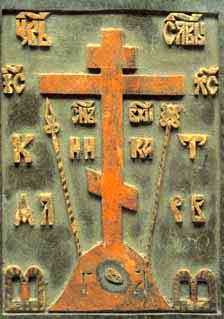
These letters, later called the monogram of Constantine, the king wore on his helmet. After the miraculous appearance of St. Constantine ordered to make images of the cross on the shields of his soldiers and installed in Constantinople three commemorative crosses with a golden inscription in Greek "IC.XP.NIKA", which means "Jesus Christ the Conqueror". He installed the first cross with the inscription "Jesus" on triumphal gates city square, the second with the inscription "Christ" - on a Roman column, and the third with the inscription "Conqueror" - on a high marble pillar on the bread square of the city. With this began the universal veneration of the Cross of Christ.
“Holy images were everywhere so that, more often visible, they would encourage us to love the Archetype,” explains Abbot Luke. “After all, everything that surrounds us affects us in one way or another, good and evil. A holy reminder of the Lord helps the soul to aspire in thought and heart to God.
As St. wrote about these times. John Chrysostom: “The cross is everywhere in glory: on houses, in the square, in solitude, on roads, on mountains, on hills, on plains, on the sea, on ship masts, on islands, on lodges, on clothes, on weapons, at feasts, on vessels of silver and gold, on precious stones, on mural painting ... so vying with each other admire this amazing gift. 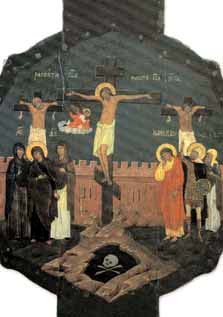
It is interesting that since the opportunity to legally make images of the cross appeared in the Christian world, encrypted inscriptions and Christograms have not disappeared, but migrated, as an addition, to the crosses themselves. This tradition also came to Russia. From the 11th century, under the lower oblique crossbar of the eight-pointed cross-crucifixion, which was installed in temples, a symbolic image of the head of Adam, who, according to legend, was buried on Golgotha, appears. The inscriptions are a brief commentary on the circumstances of the crucifixion of the Lord, the meaning of His death on the cross, and are deciphered as follows: "M.L.R.B." - “the place of the frontal was crucified”, “G.G.” - "Mount Golgotha", The letters "K" and "T" mean a spear of a warrior and a cane with a sponge, depicted along the cross. The inscriptions are placed above the middle crossbar: "IC" "XC", and below it: "NIKA" - "Winner"; on the plate or near the inscription: “SN BZHIY” - “Son of God”, “I.N.Ts.I” - “Jesus of Nazareth King of the Jews”; above the plate there is an inscription: "ЦРЪ СЛАВЫ" - "King of Glory". "G.A." - "Head of Adam"; moreover, the bones of the hands lying in front of the head are depicted: right on the left, as during burial or communion.
Catholic or Orthodox Crucifixion?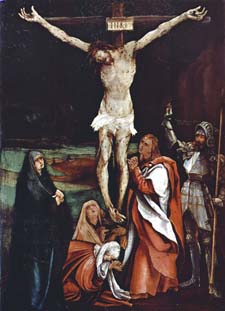
“The Catholic Crucifixion is often written in a more naturalistic way,” says Svetlana Gnutova. - The Savior is depicted sagging in his arms, the image conveys the martyrdom and death of Christ. In ancient Russian images, Christ is depicted as Risen and Reigning. Christ is depicted in power - as a conqueror, holding and calling the whole Universe into His arms.
In the 16th century, the Moscow clerk Ivan Mikhailovich Viskovaty even spoke out against crosses, where Christ is depicted on the cross with clenched into a fist, and not open palms. “Christ stretched out his hands on the cross to gather us together,” hegumen Luke explains, “so that we rush to heaven, so that our aspiration will always be towards the heavenly. Therefore, the cross is also a symbol of gathering us together so that we can be one with the Lord!” 
Another difference Catholic Crucifix- Christ Crucified with three nails, that is, the nails were driven into both hands, and the soles of the feet were put together and nailed with one nail. In the Orthodox Crucifixion, each foot of the Savior is nailed separately with its own nail. Abbot Luke: "That's enough ancient tradition. In the 13th century, custom-made icons for the Latins were painted in Sinai, where Christ was already nailed with three nails, and in the 15th century such Crucifixes become the generally accepted Latin norm. However, this is only a tribute to tradition, which we must respect and preserve, but not look for any theological load here. In the Sinai Monastery, the icons of the Lord crucified with three nails are in the temple and are revered on a par with Orthodox crucifixes.
Cross - Love crucified
“The iconography of the cross is evolving like any other iconography. The cross can be decorated with ornaments or stones, but in no way can it become 12-pointed or 16-pointed,” says Svetlana Gnutova. "The variety of forms of the cross in Christian tradition- this is a variety of glorification of the Cross, and not a change in its meaning, - explains Abbot Luke. - Hymnographers glorified the Cross with many prayers, just as icon painters glorify the Cross of the Lord in different ways. For example, an image of a tsata appeared in icon painting - a royal or princely pendant in the shape of a crescent, in our country it is usually used on the icons of the Virgin and Christ, - it soon appeared on the cross to emphasize its royal significance.
Of course, we need to use the crosses that are written in Orthodox tradition. After all, the cross on the chest is not only the help that we resort to in prayers, but also the evidence of our faith. Although, I think we can accept images of crosses of ancient Christian denominations (for example, Copts or Armenians). Catholic crosses, which after the Renaissance became too naturalistic in form, do not coincide with the Orthodox understanding of Christ Crucified as the Conqueror, but since this is an image of Christ, we must treat them with reverence.
As St. John of Kronstadt: “The main thing that should remain in the Cross is Love: “The Cross without love cannot be thought and imagined: where the cross is, there is love; in church you see crosses everywhere and on everything so that everything reminds you that you are in the temple of Love, crucified for us.